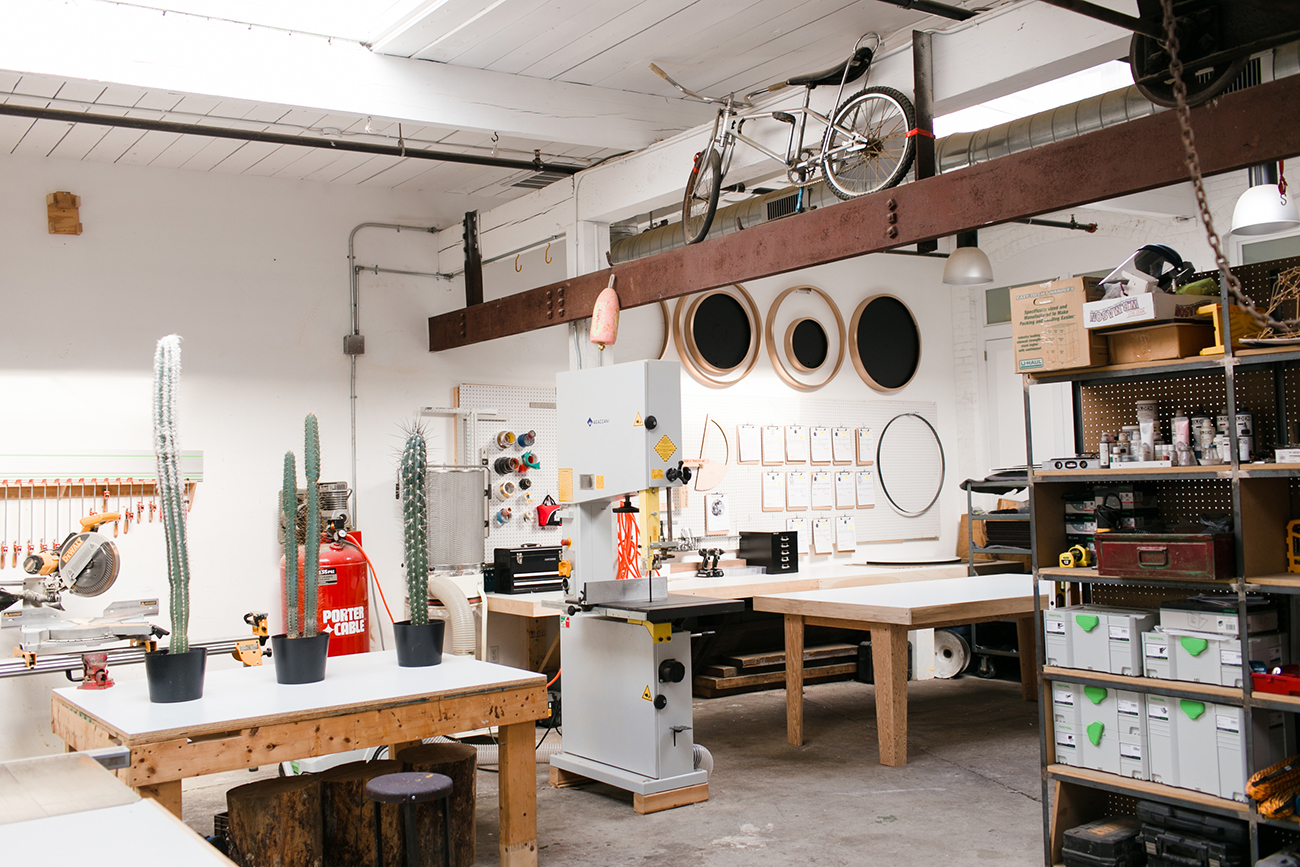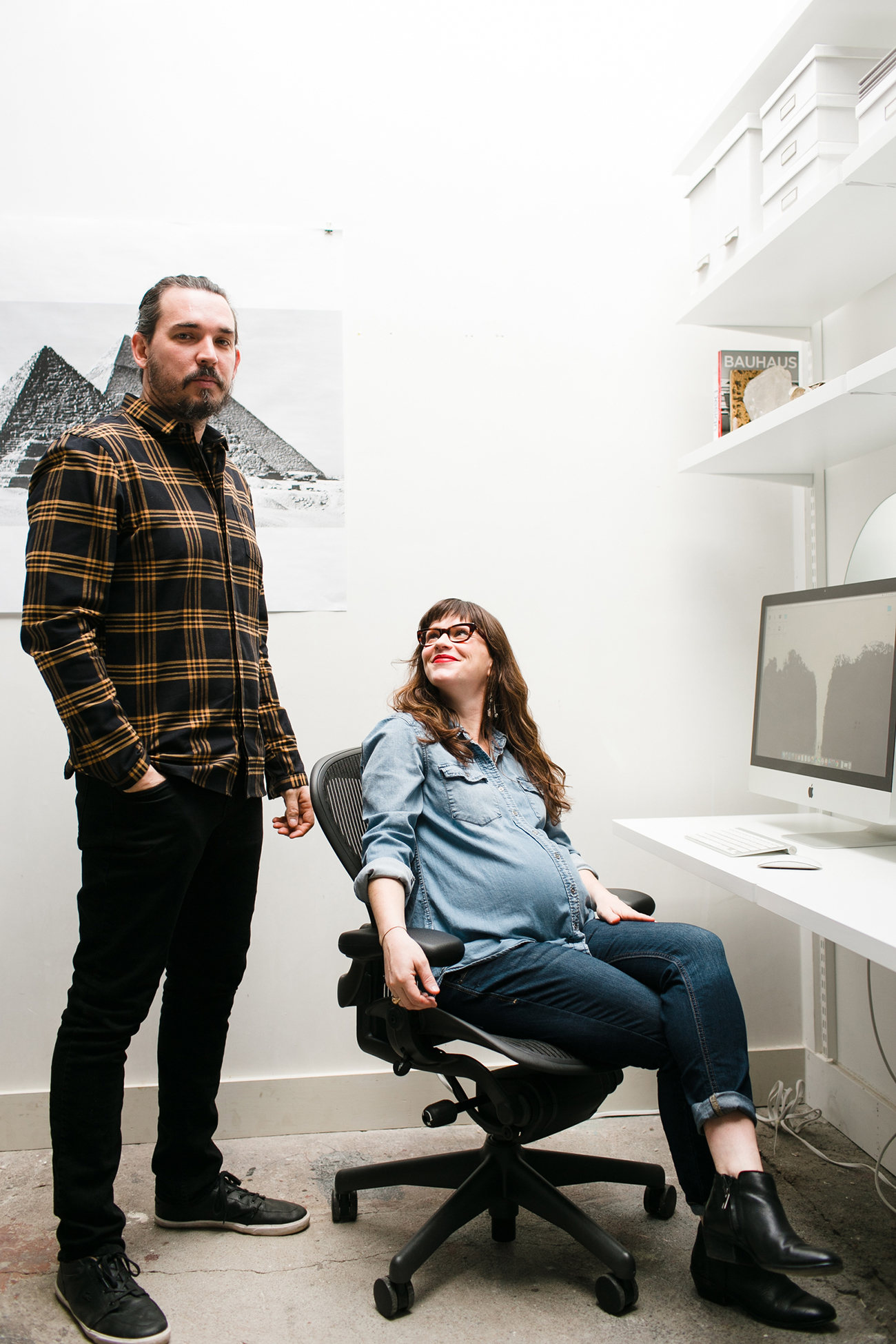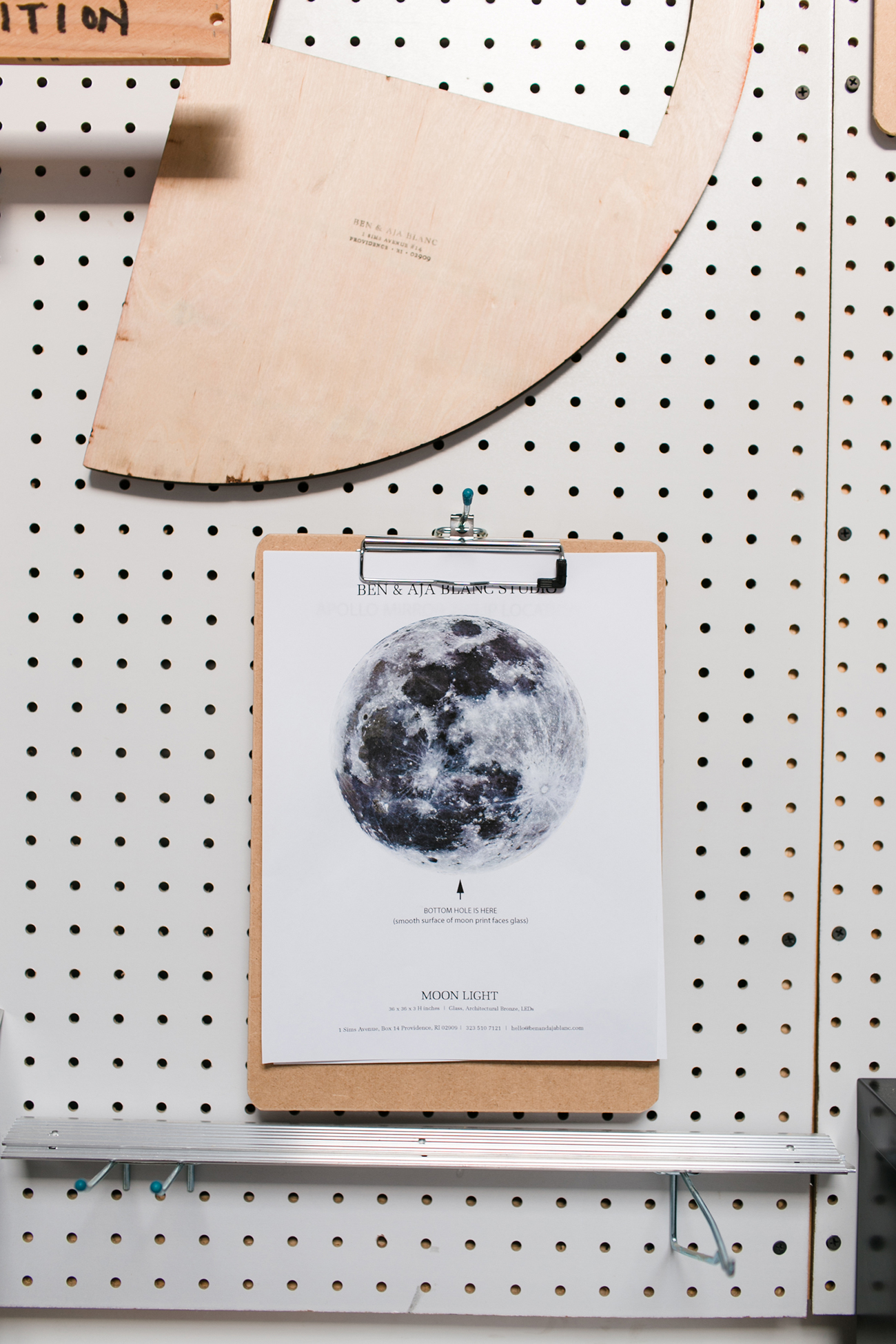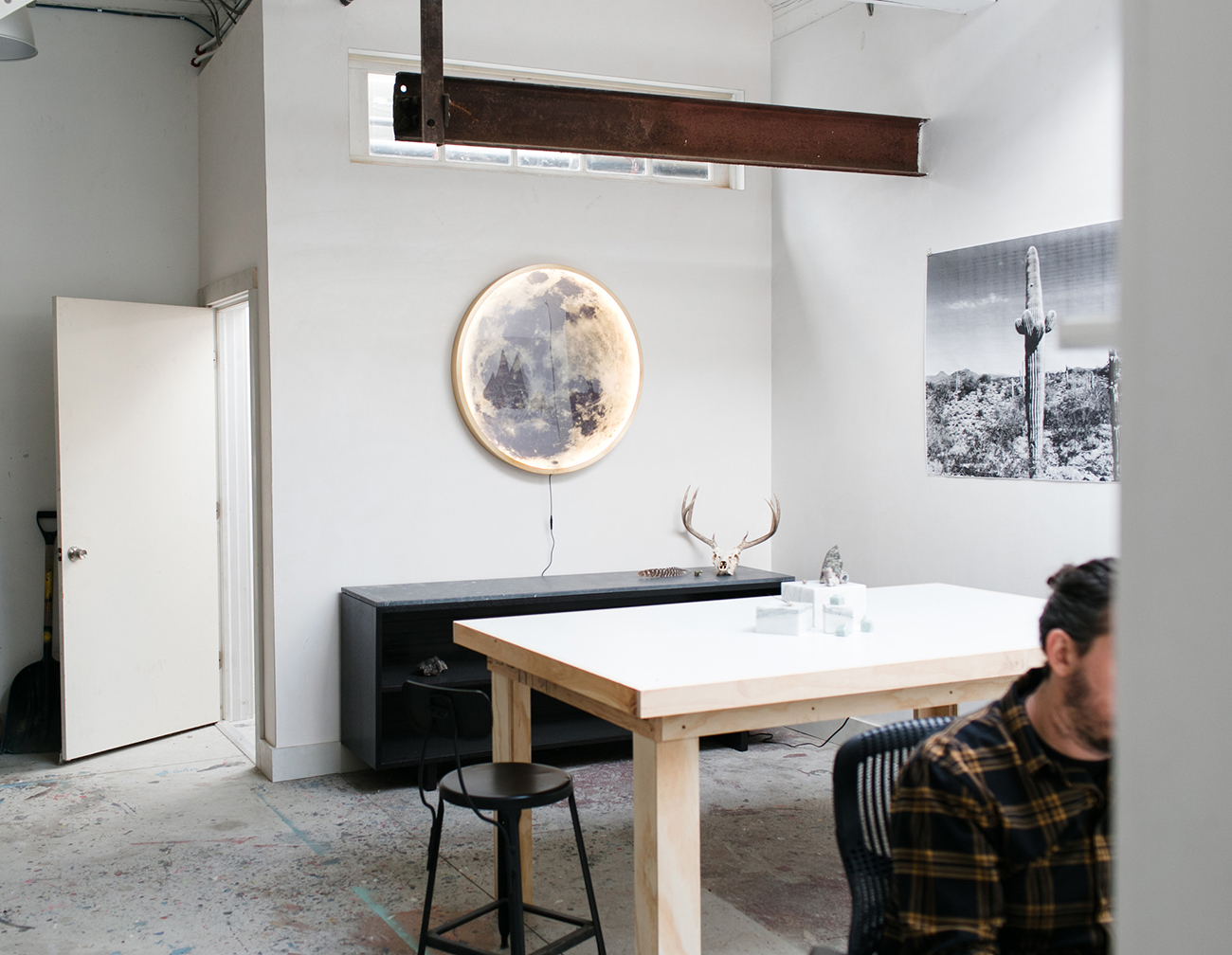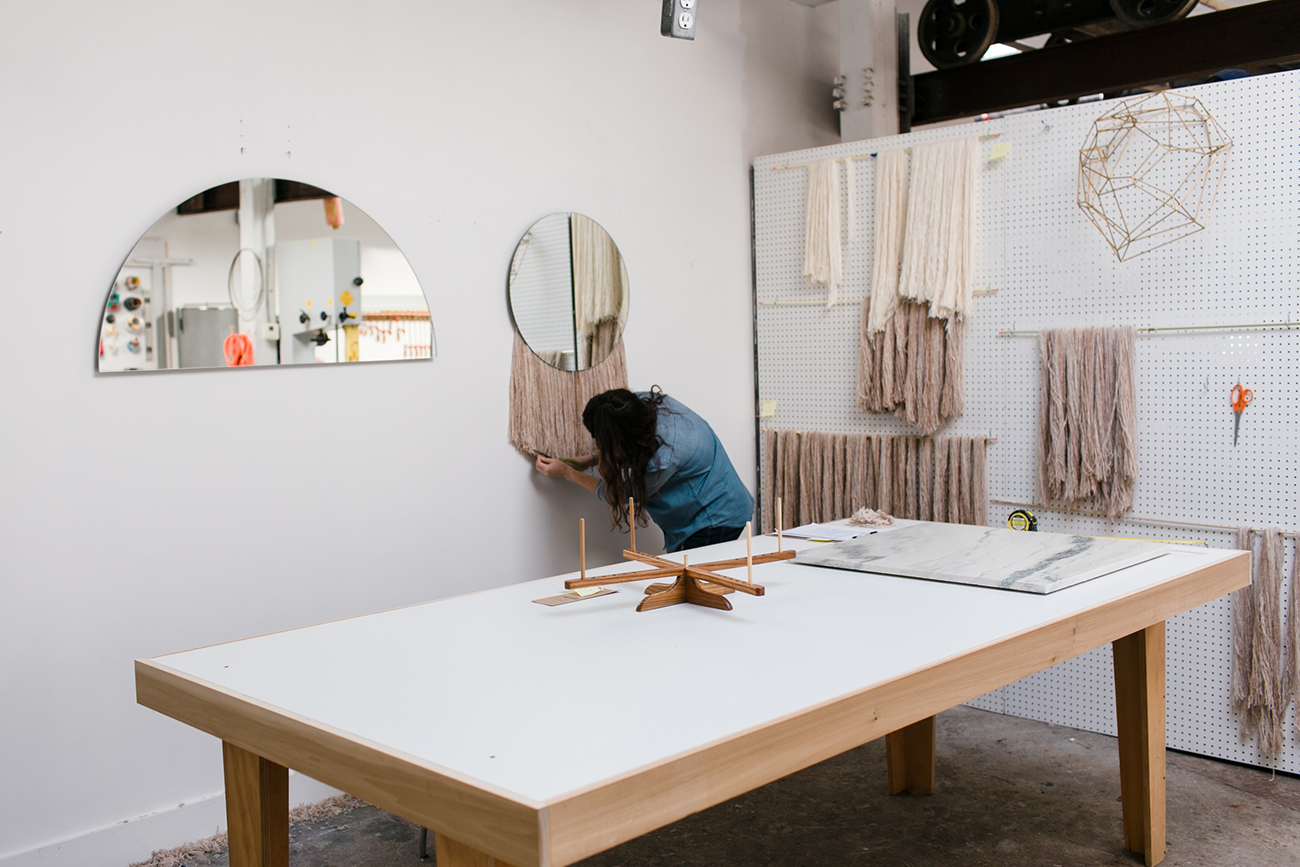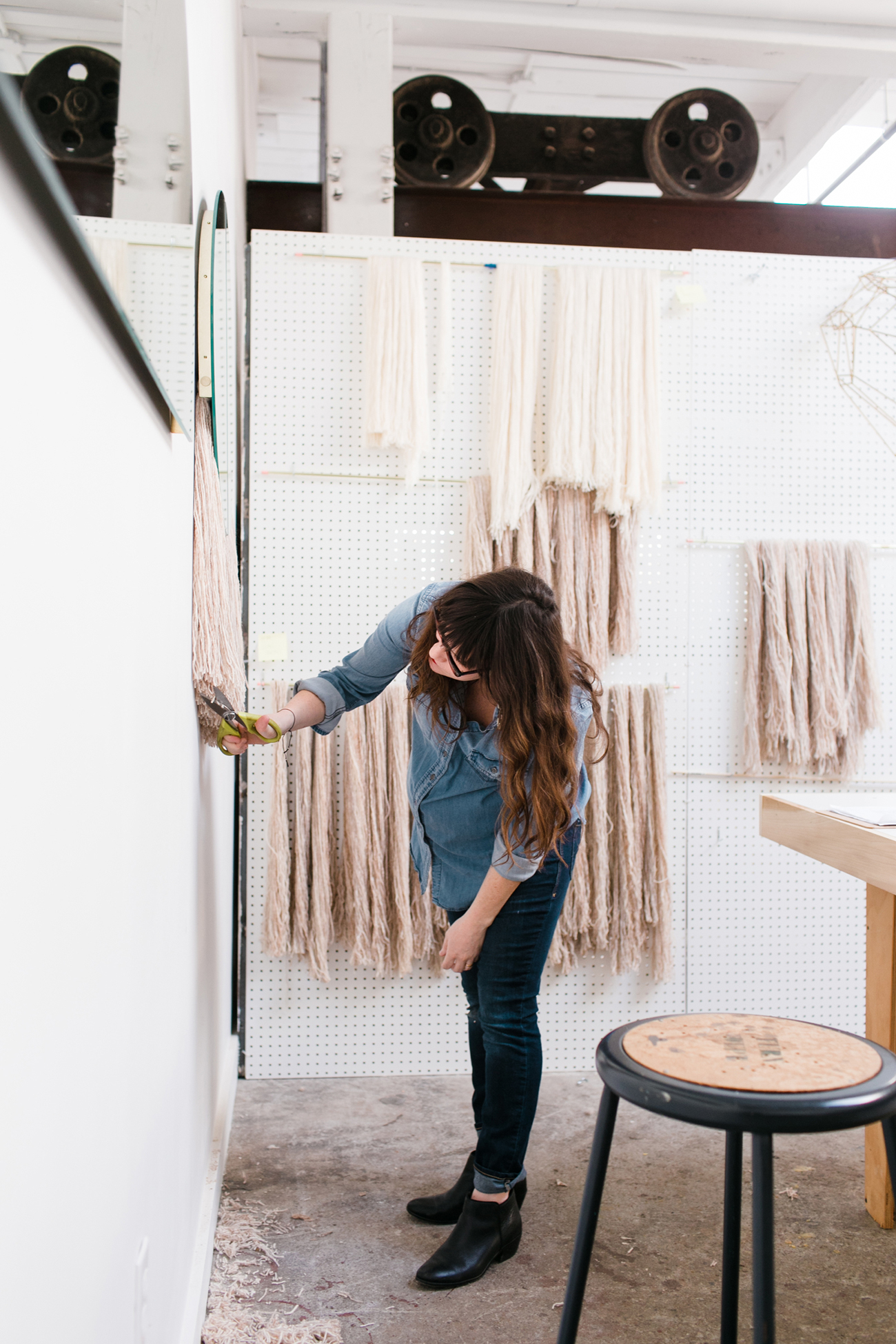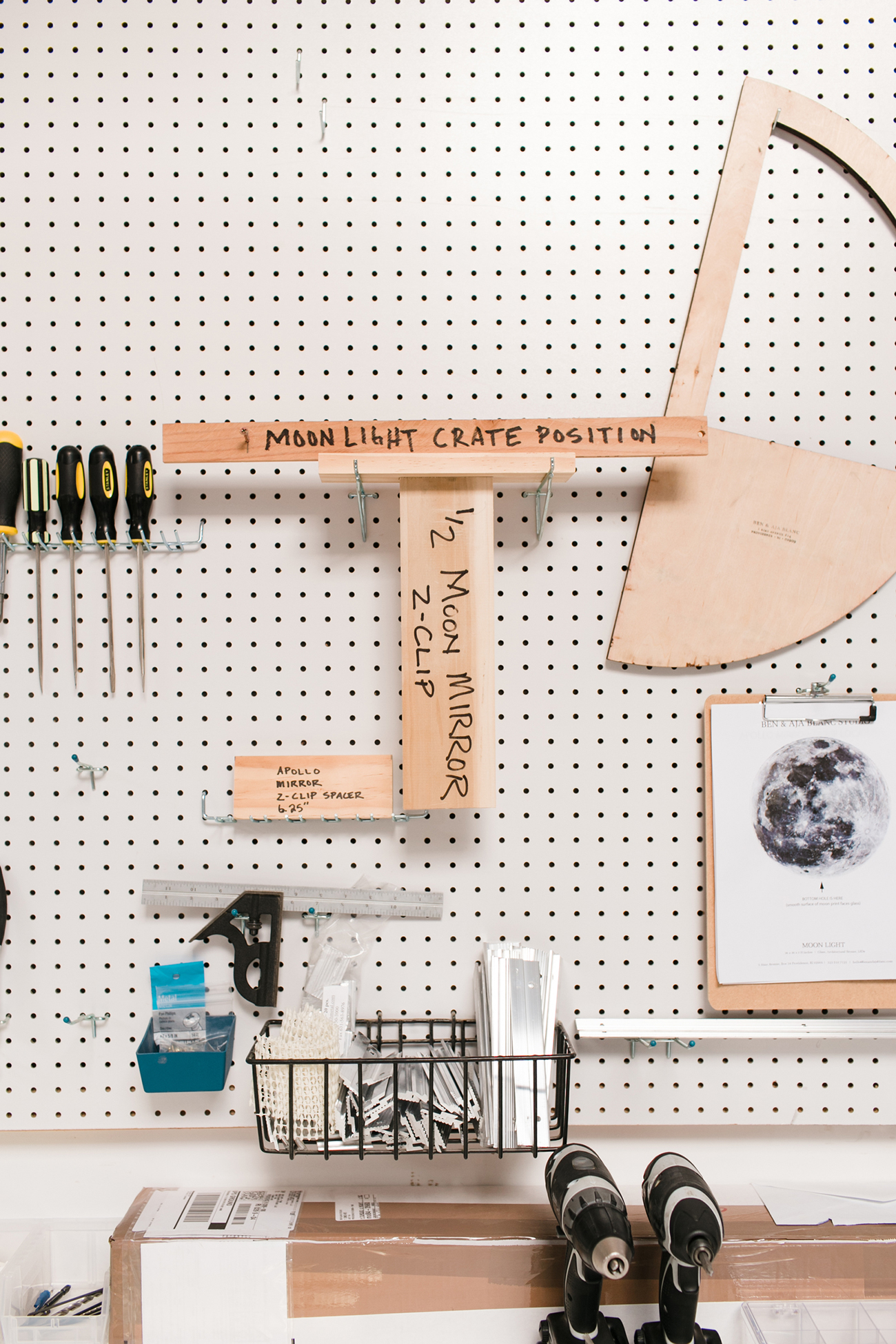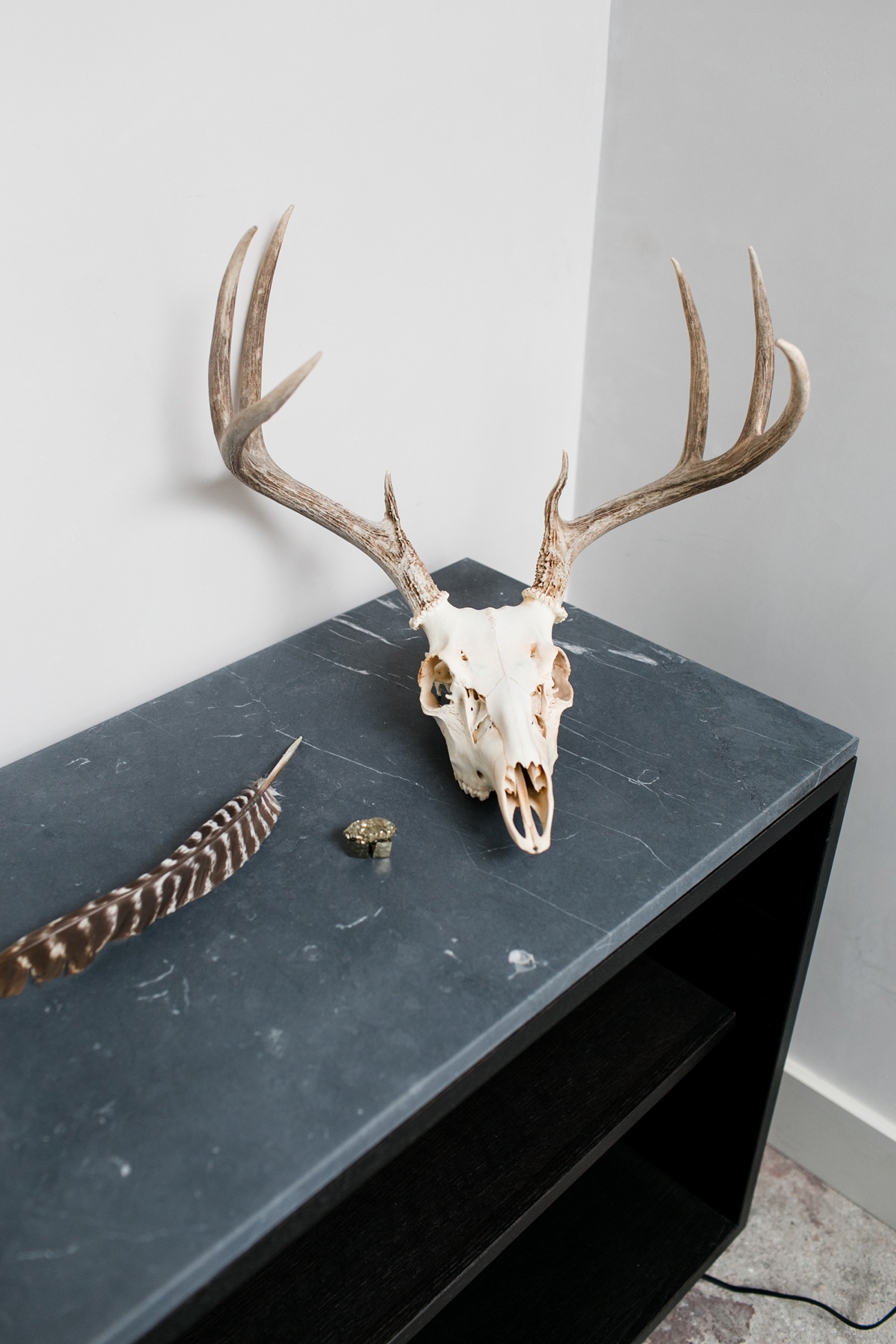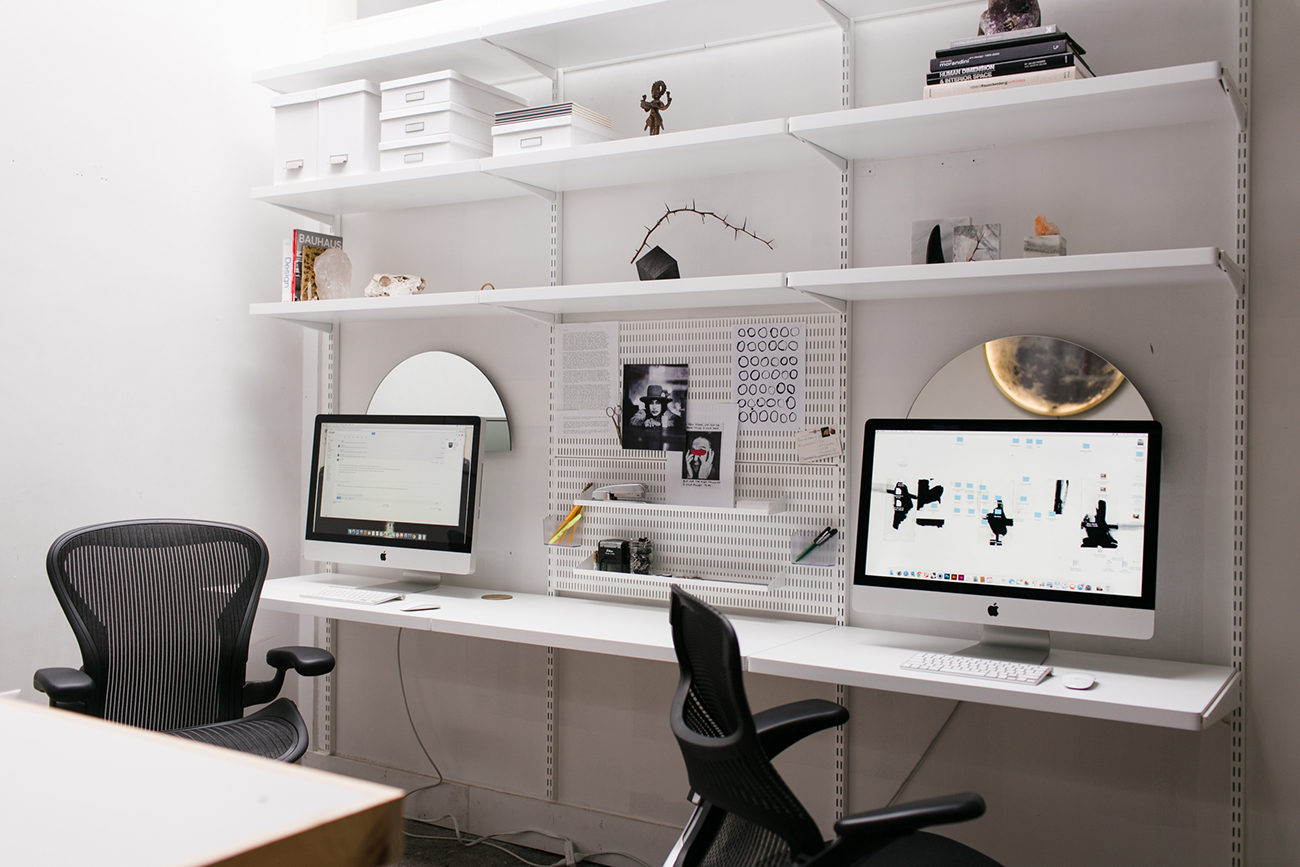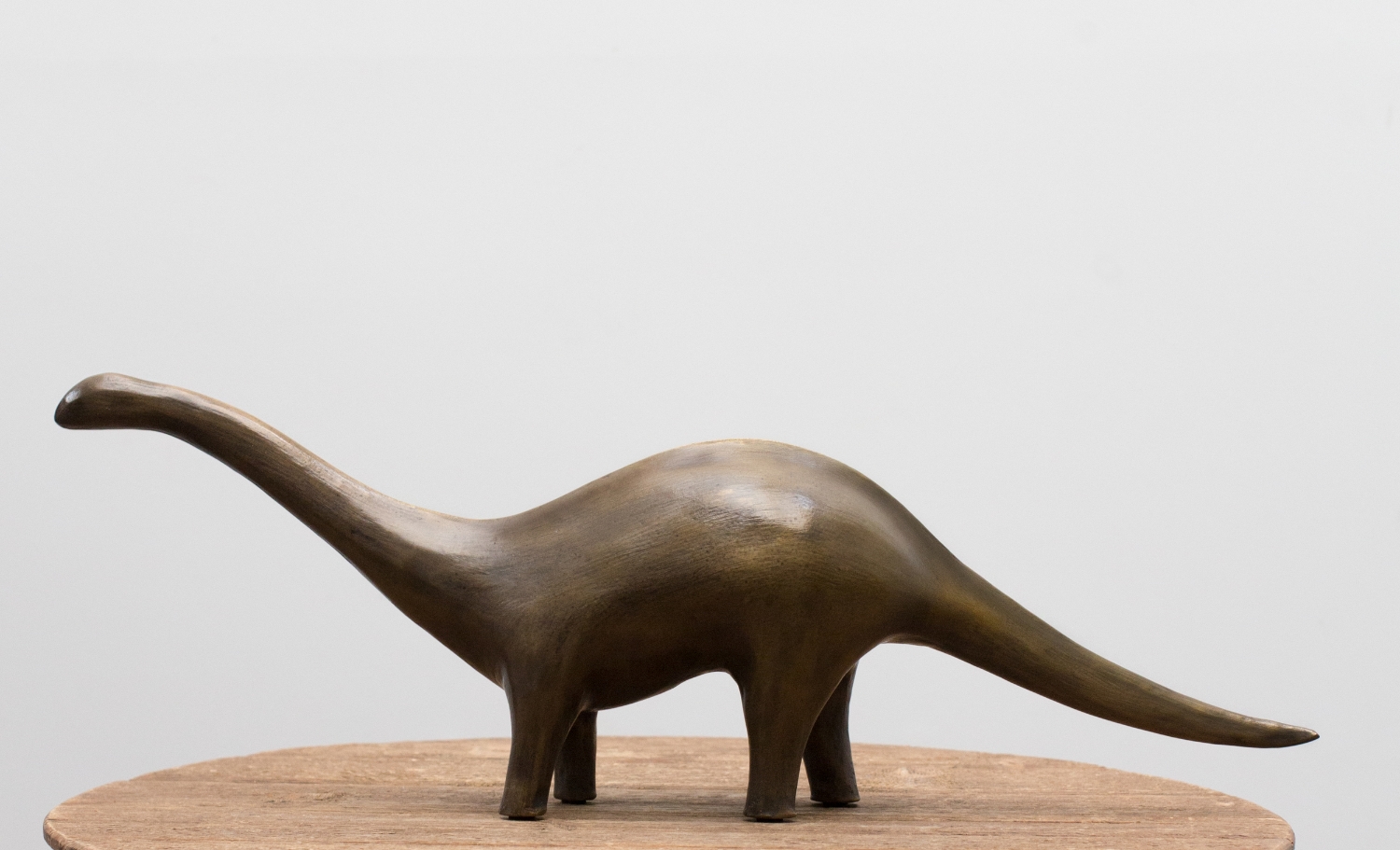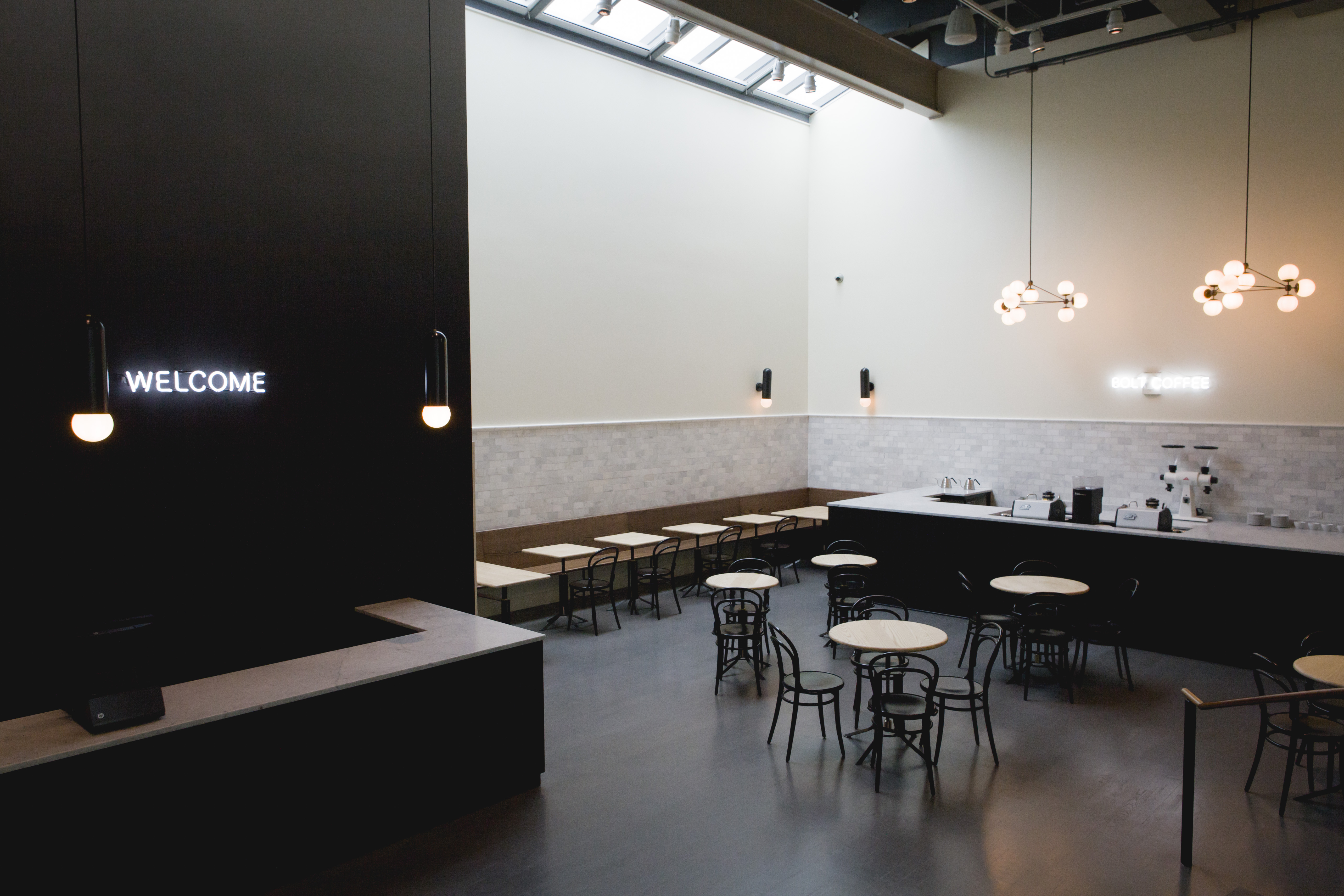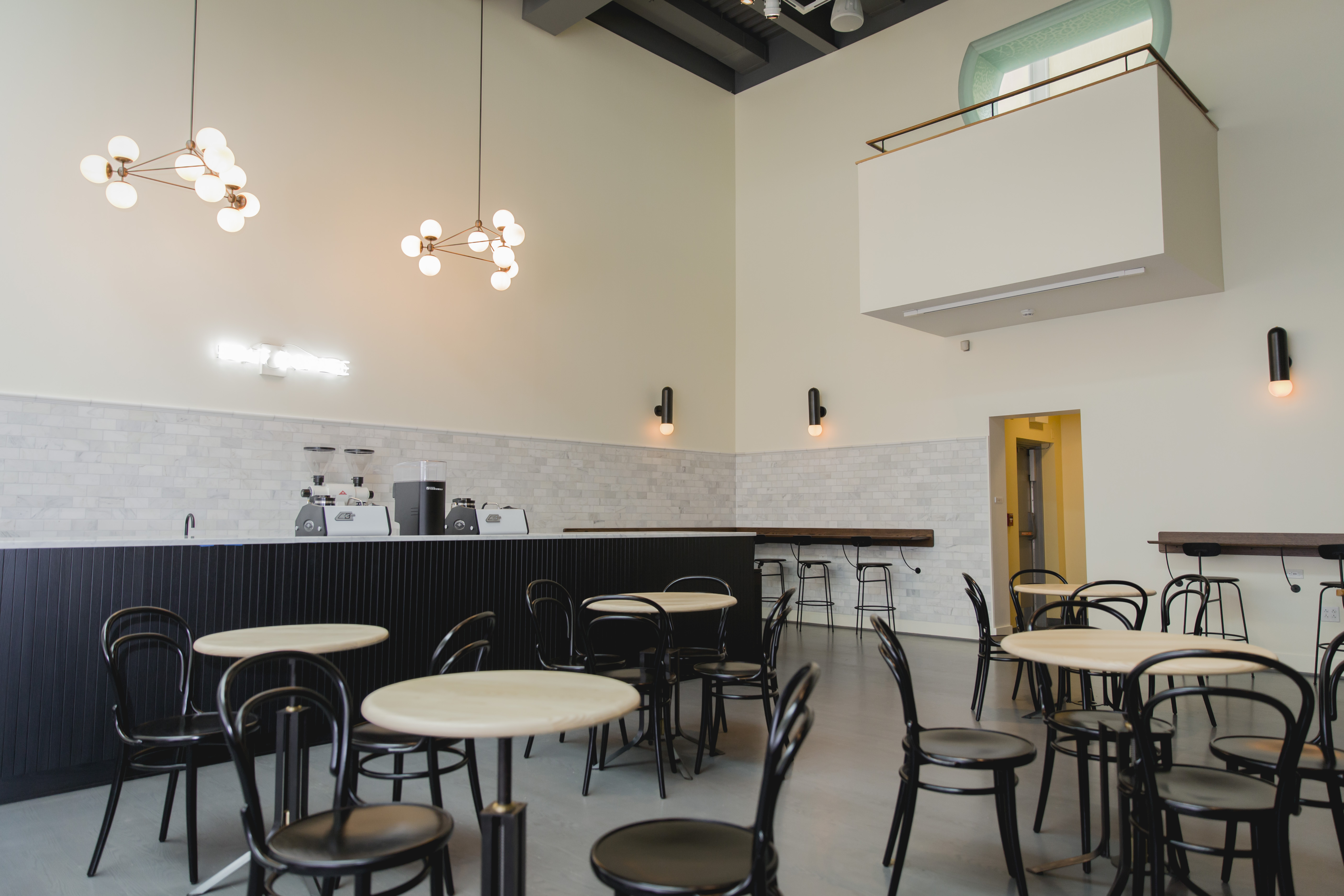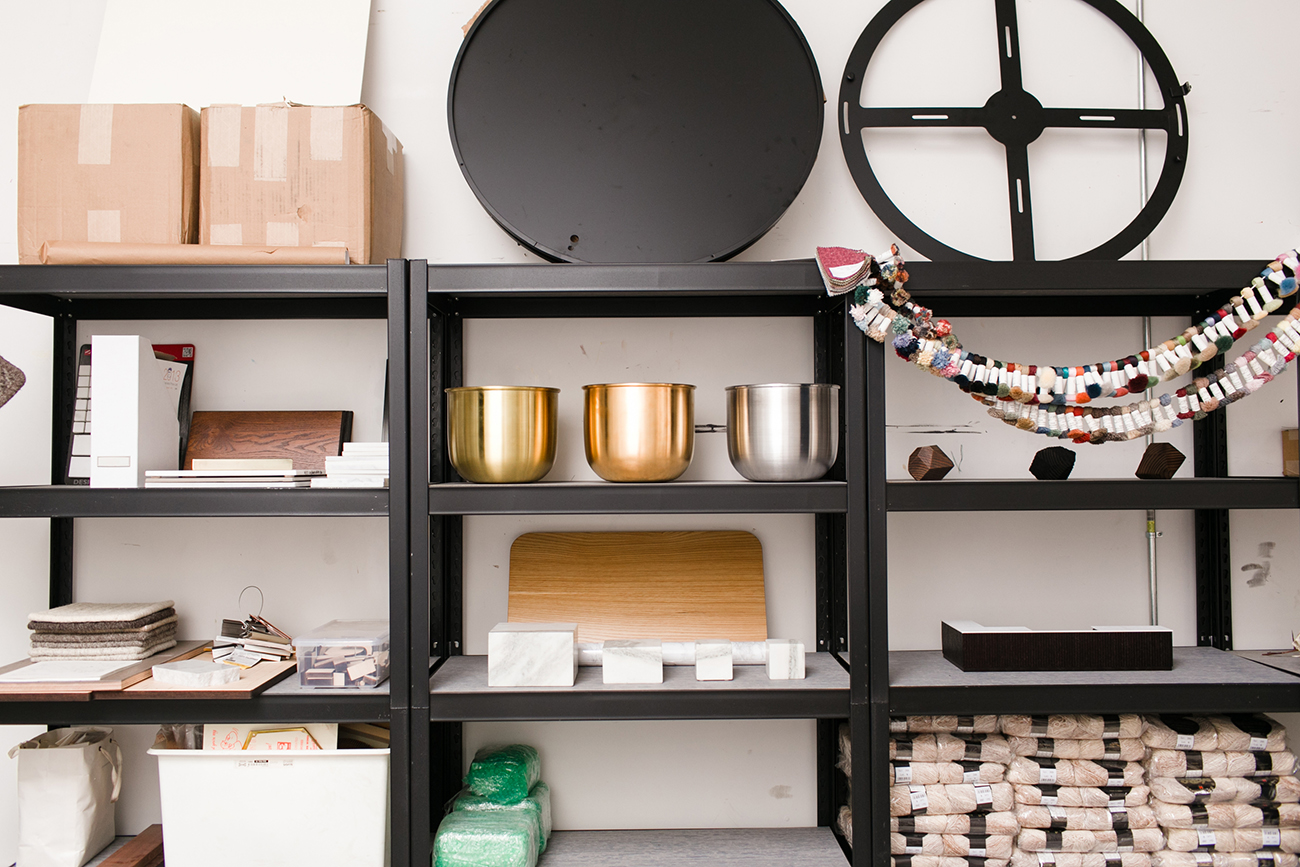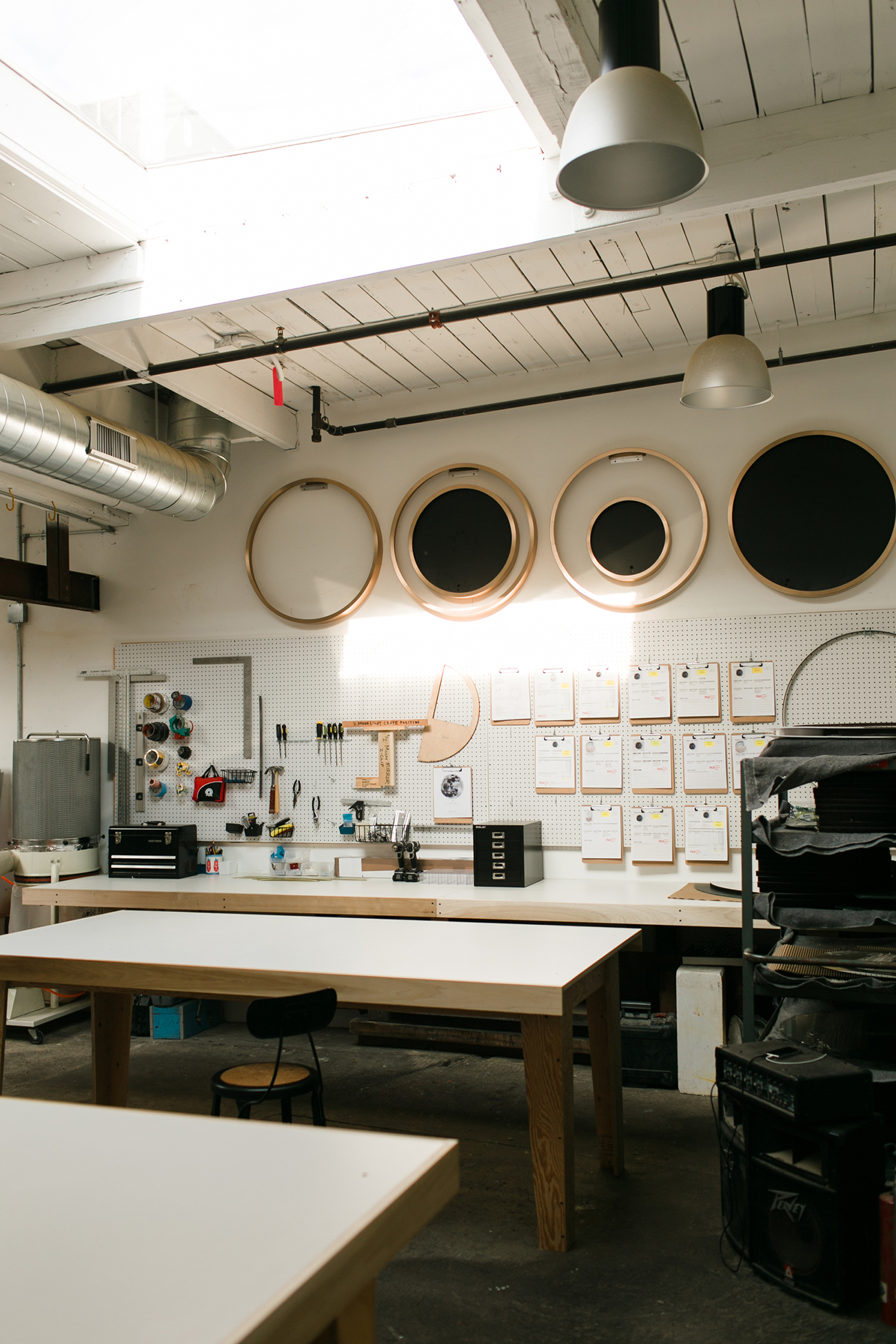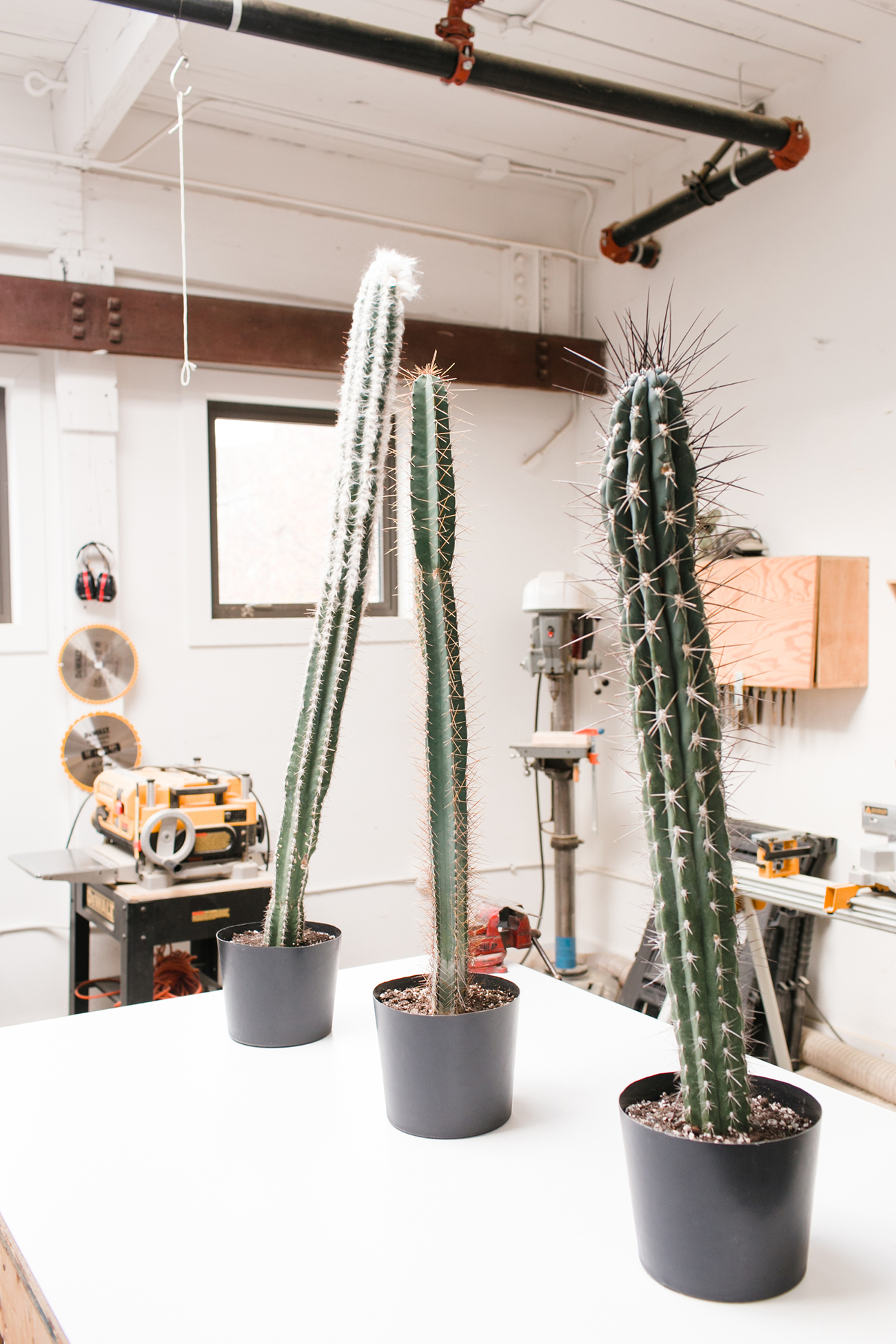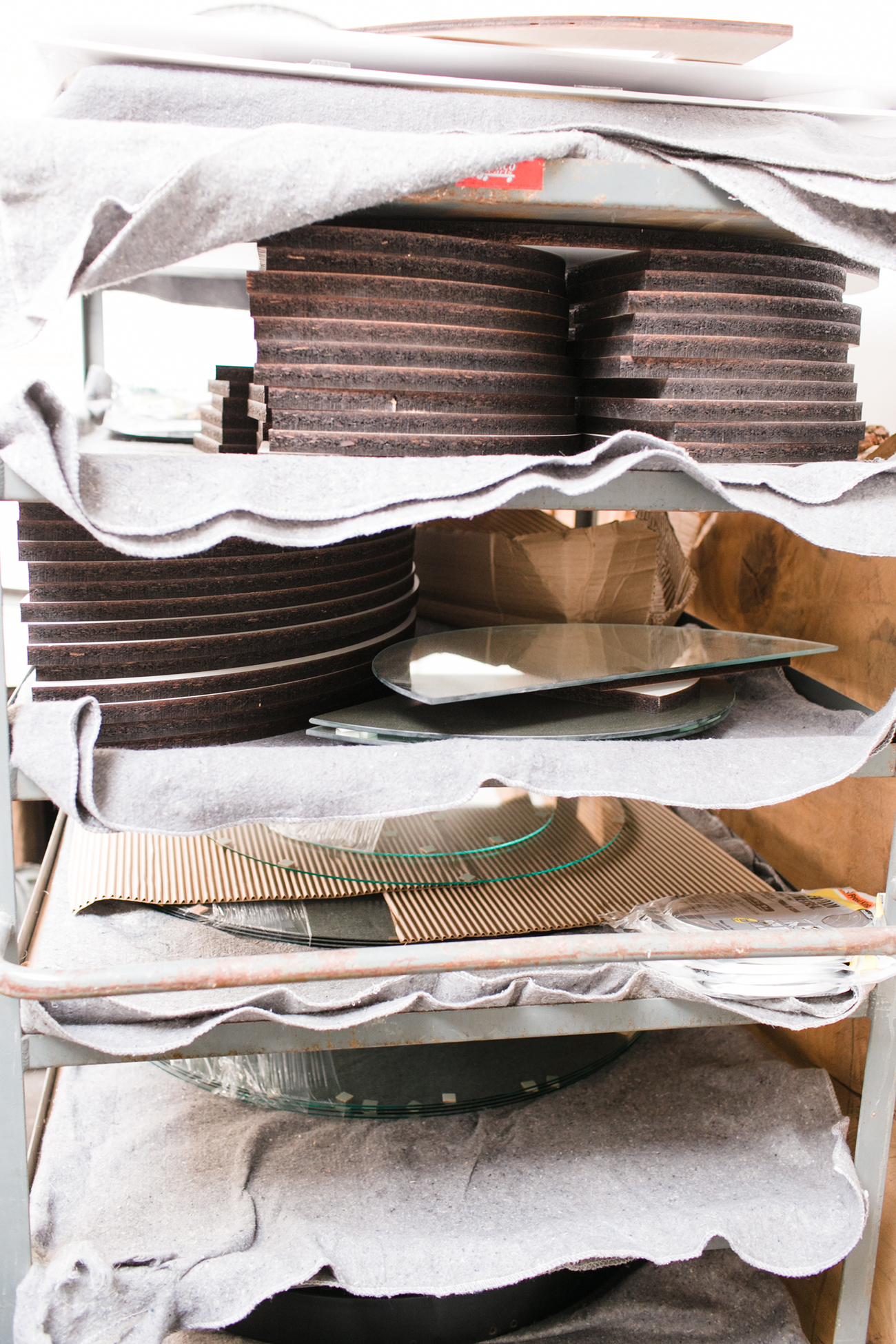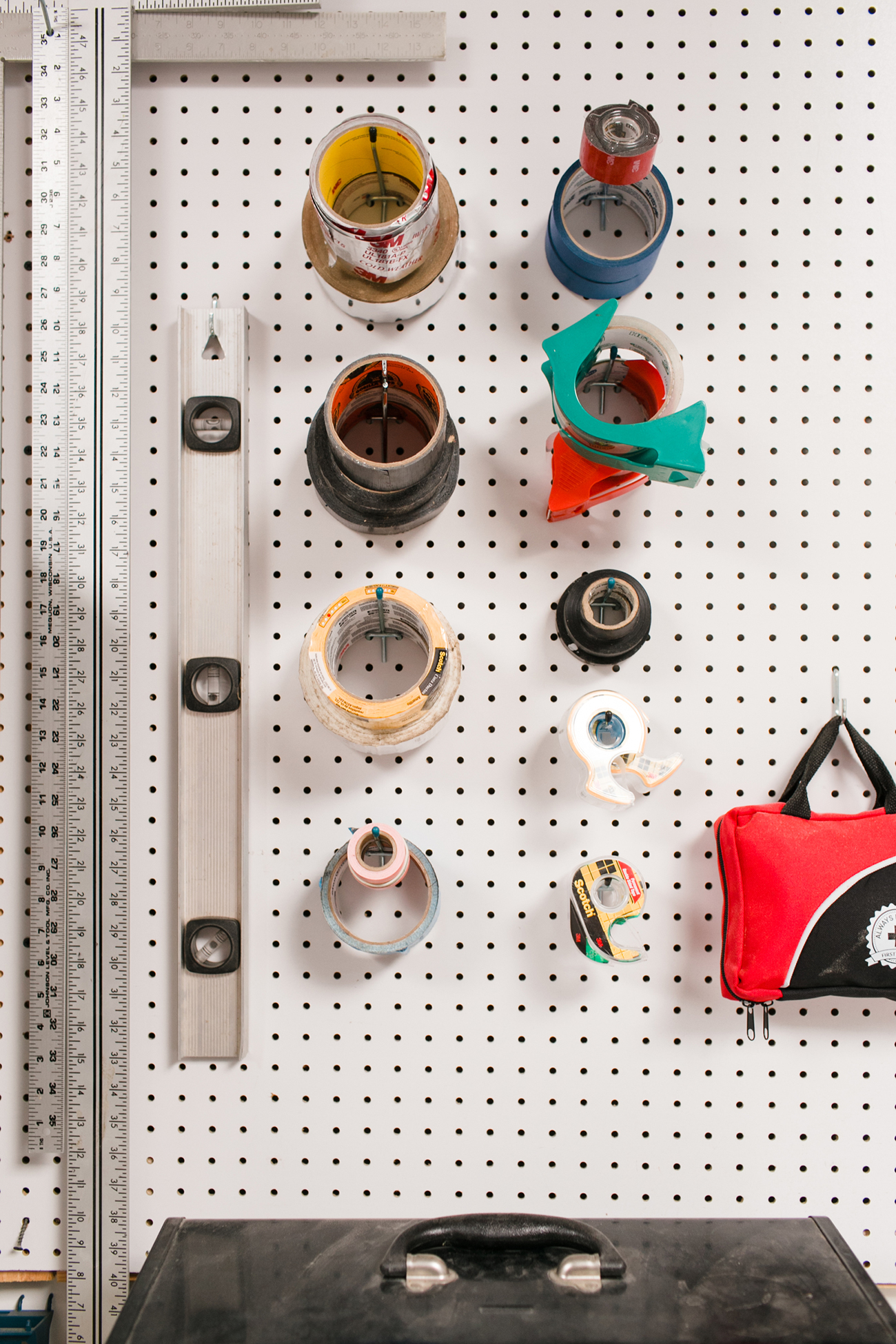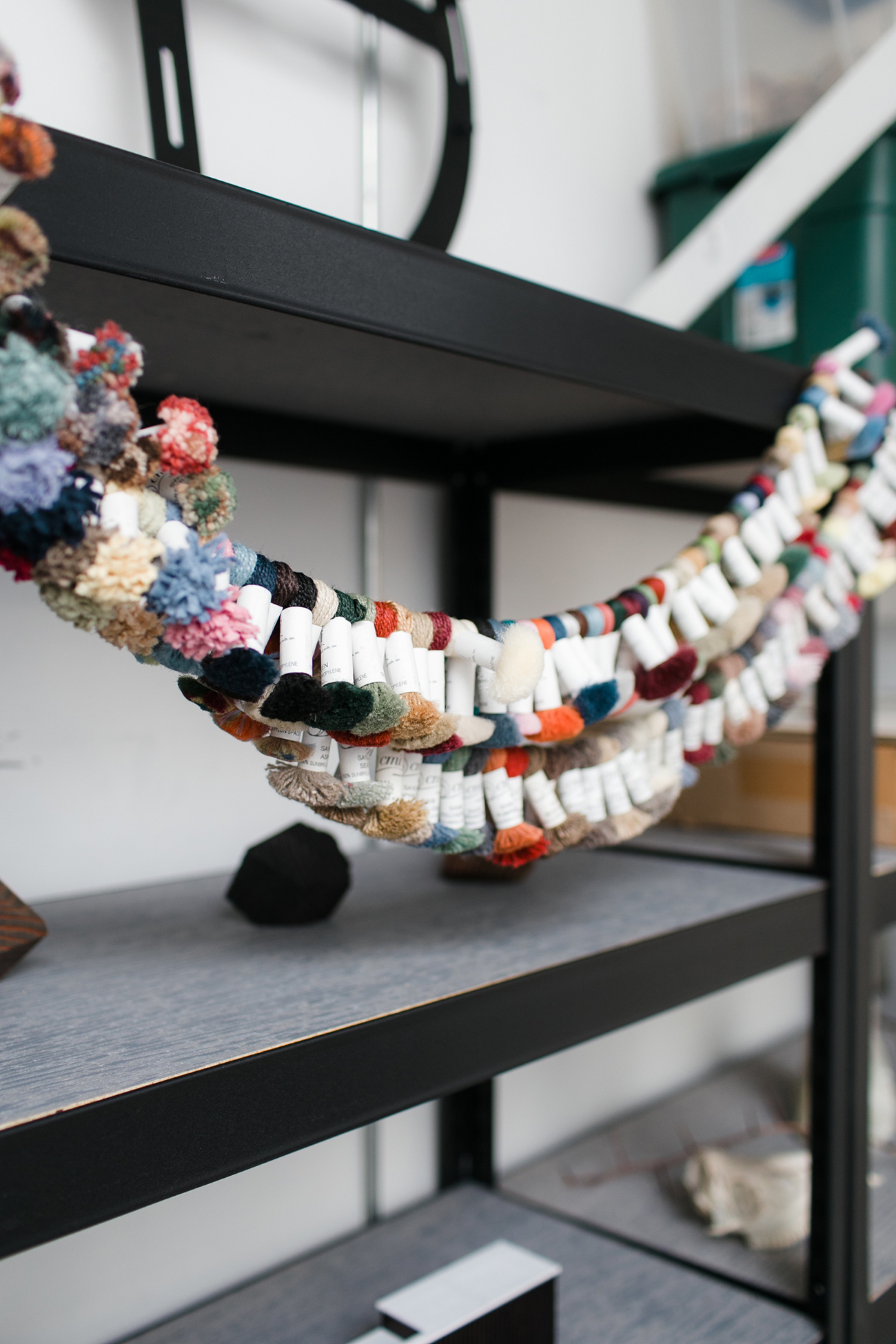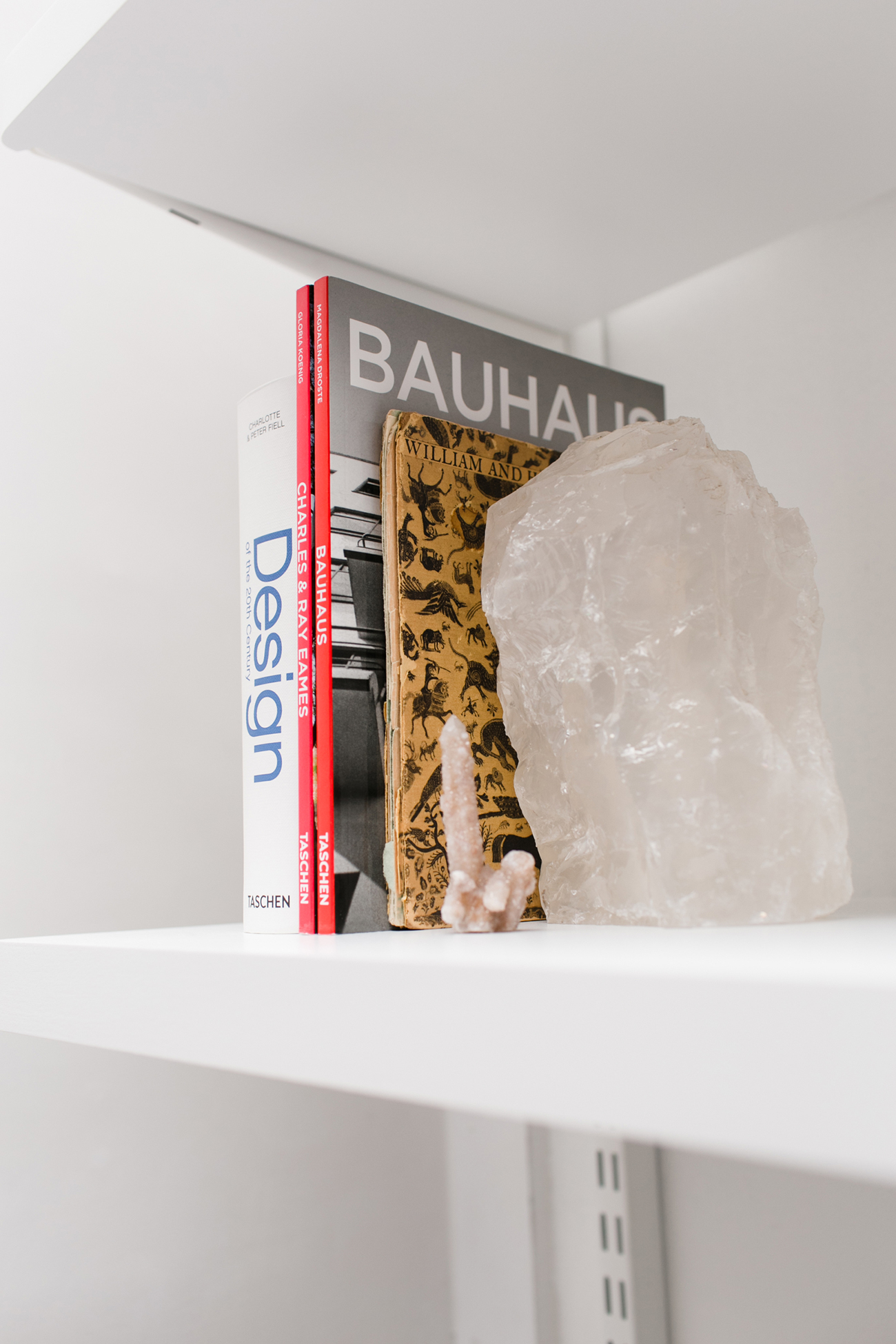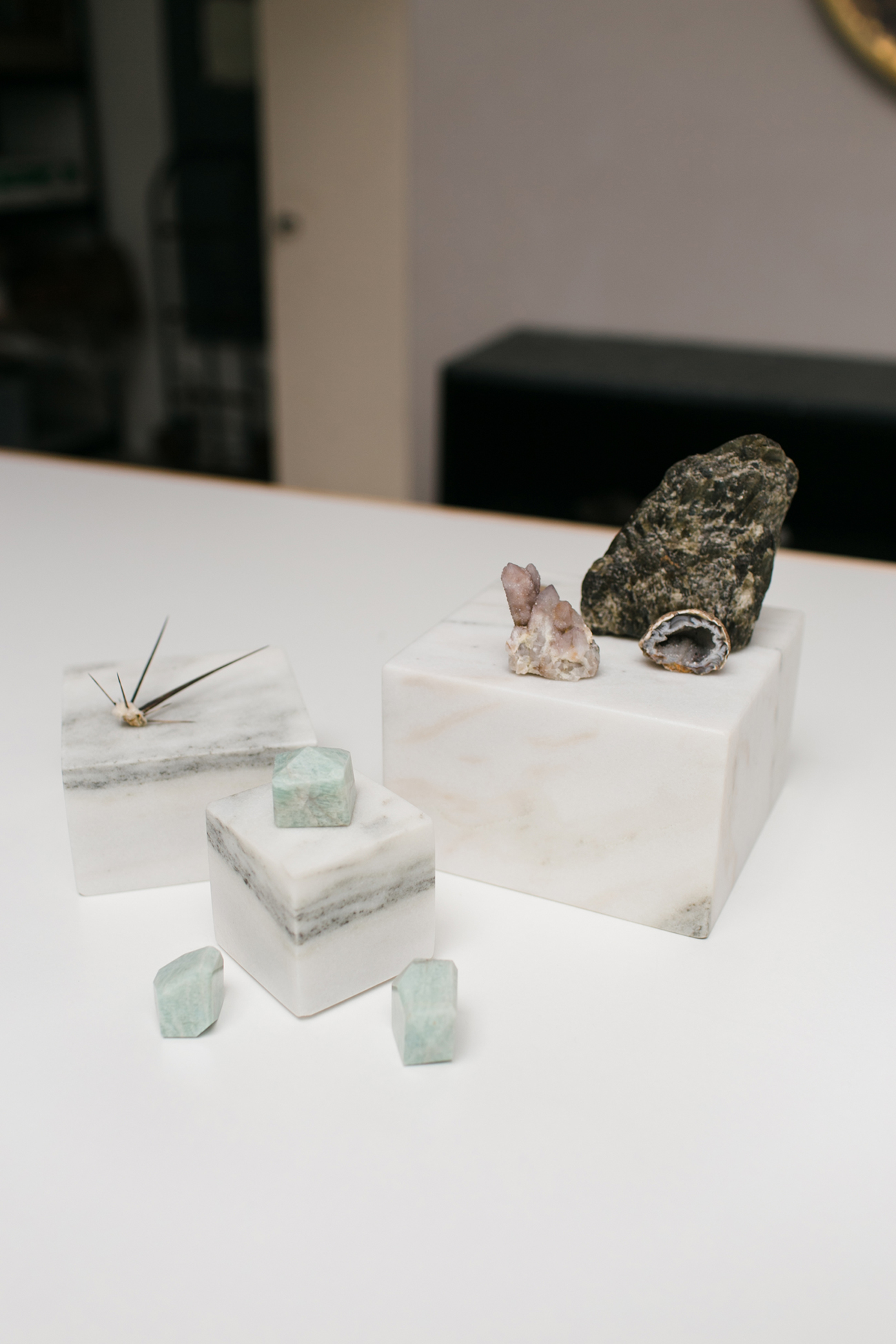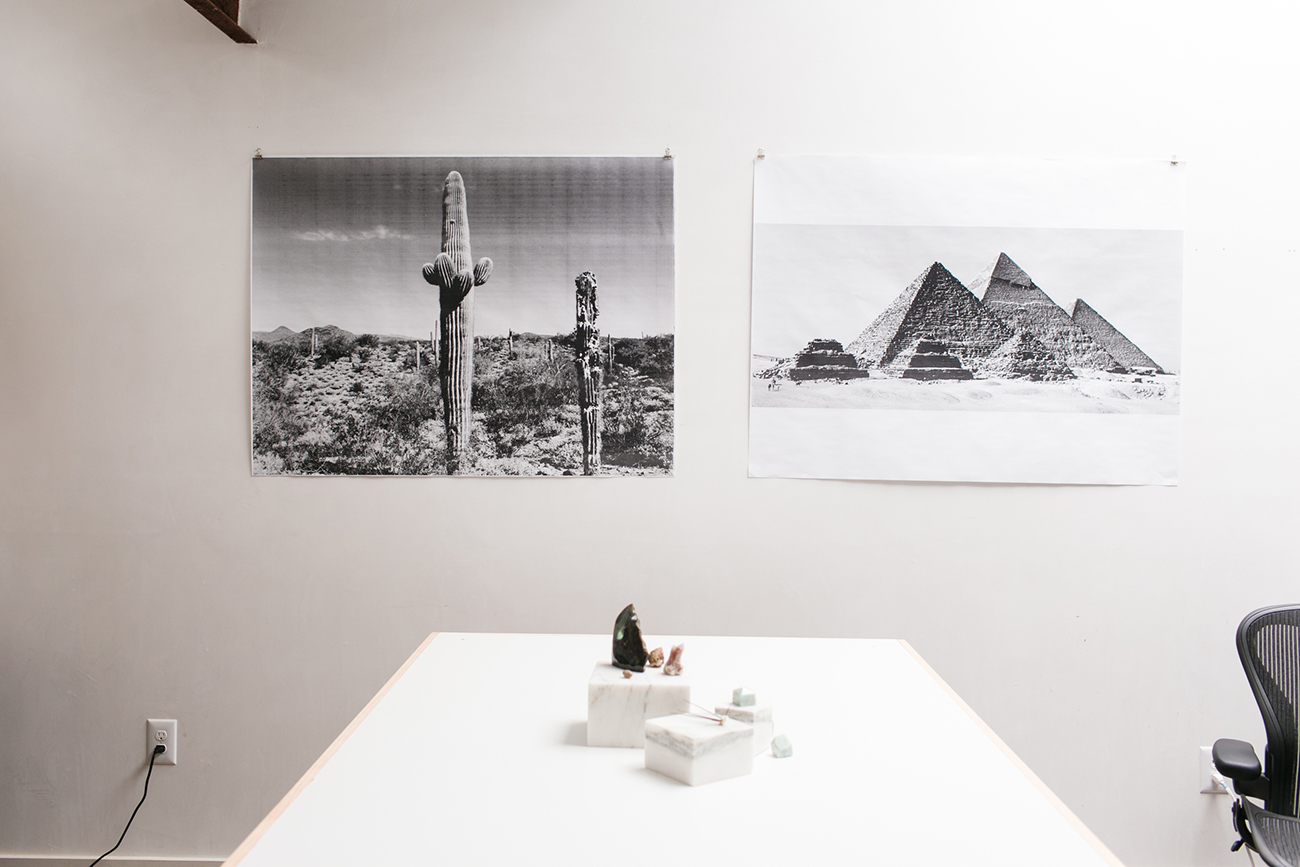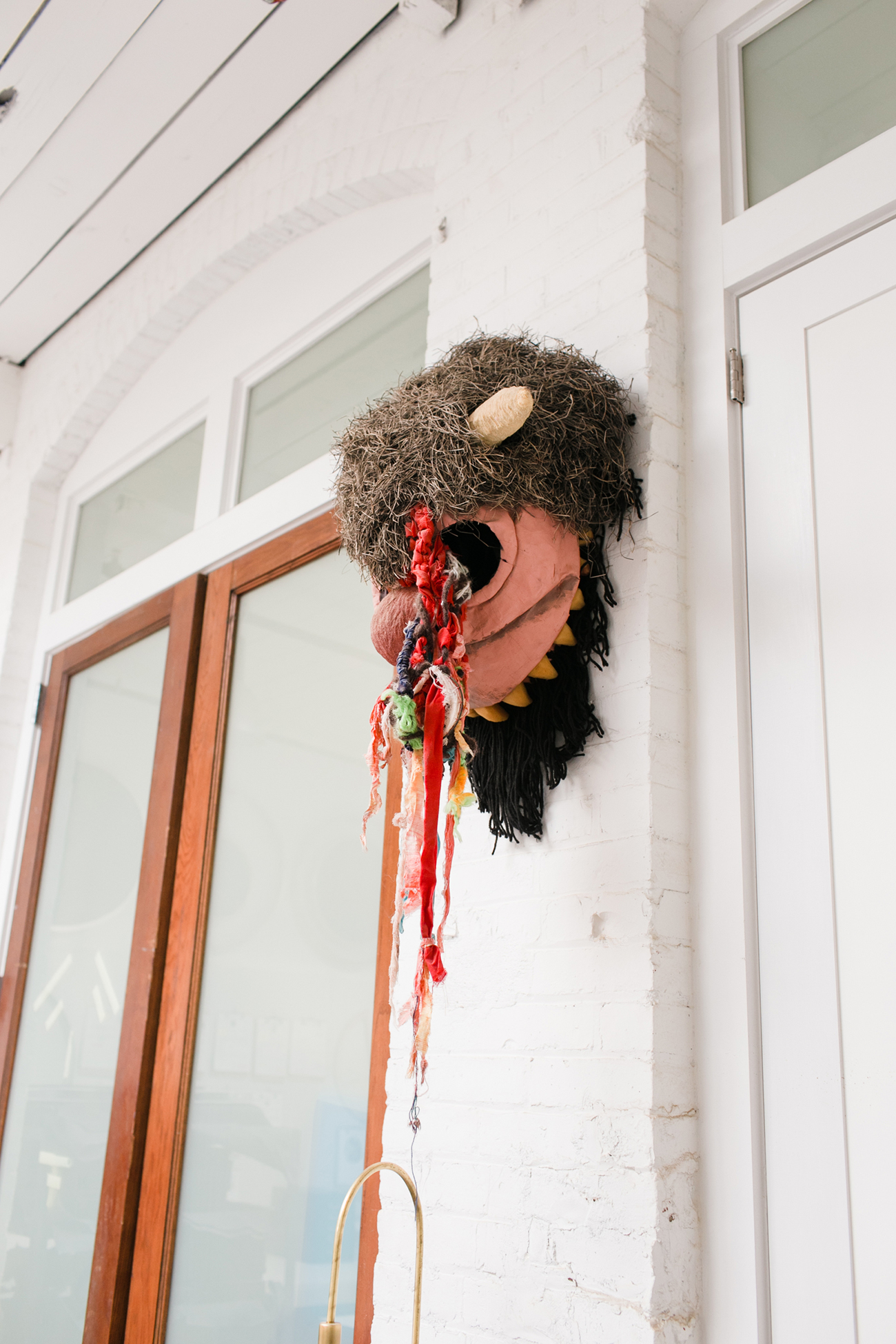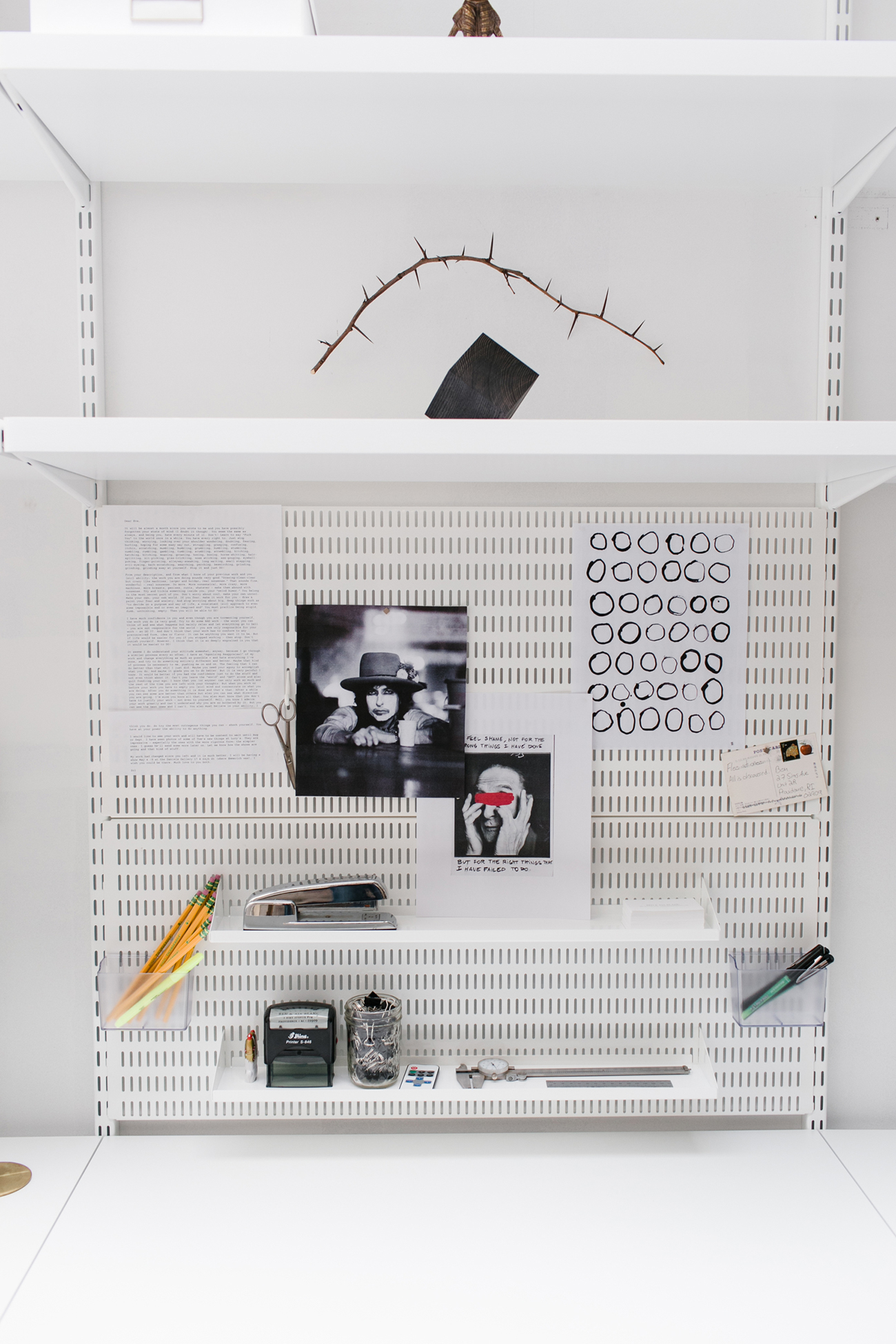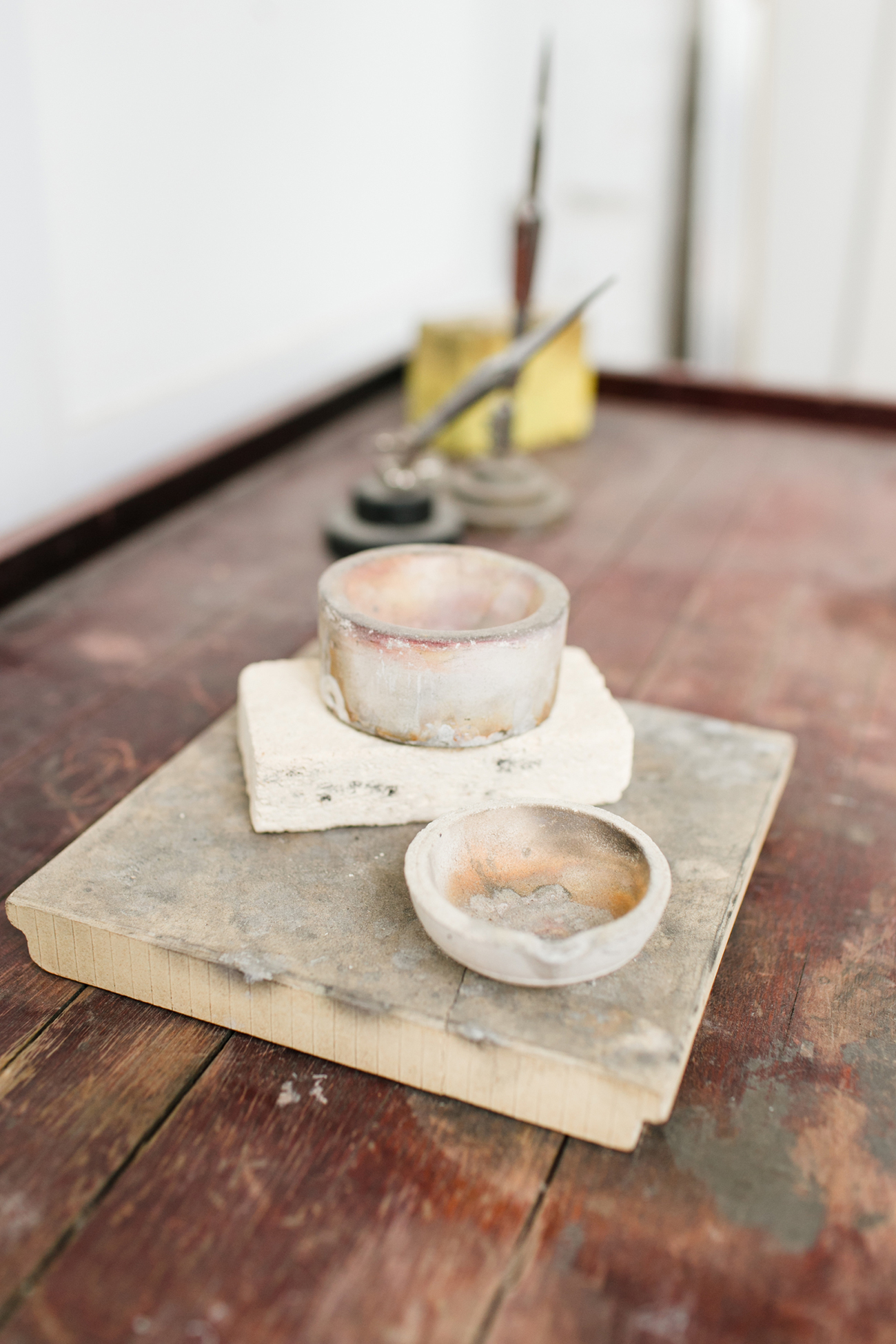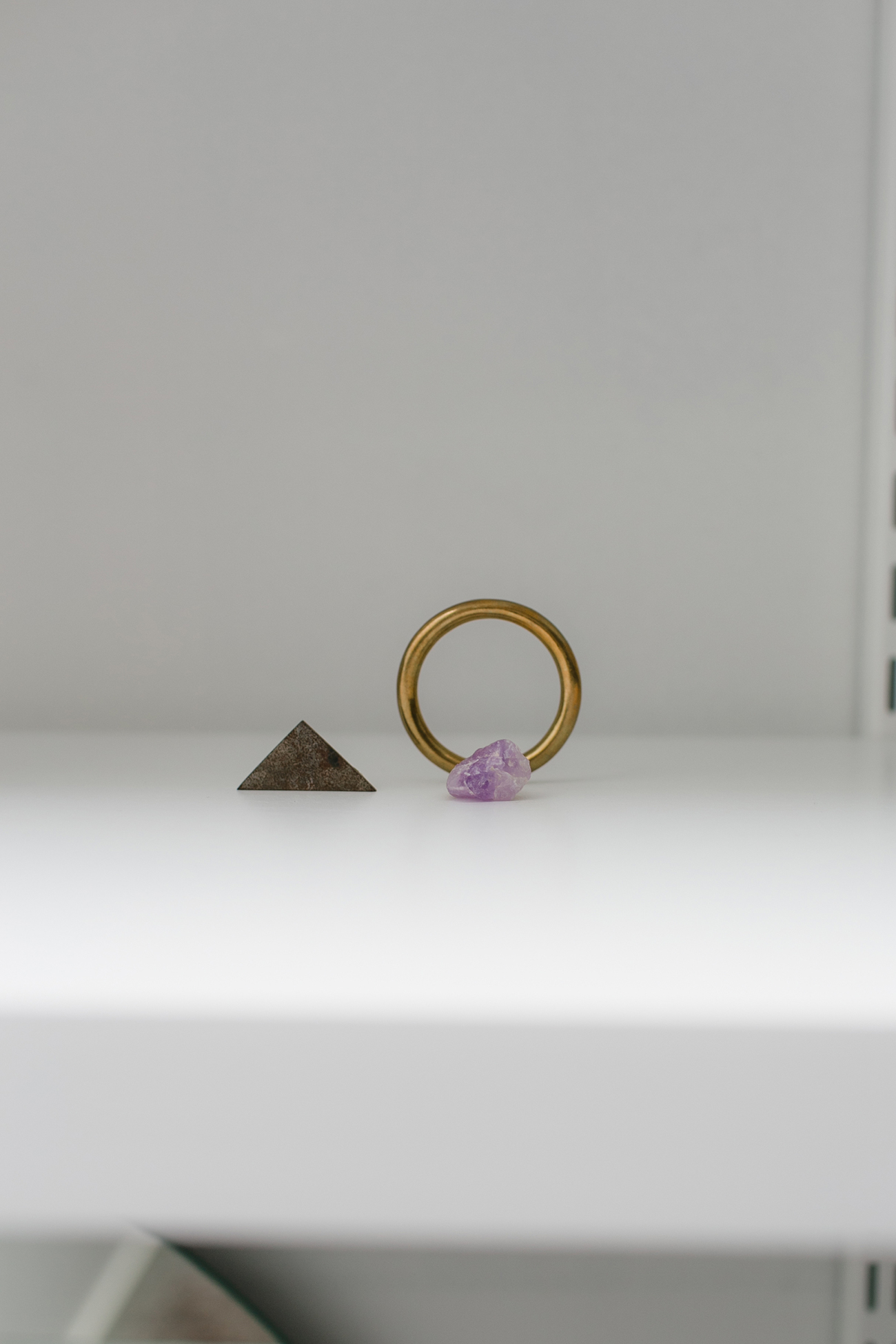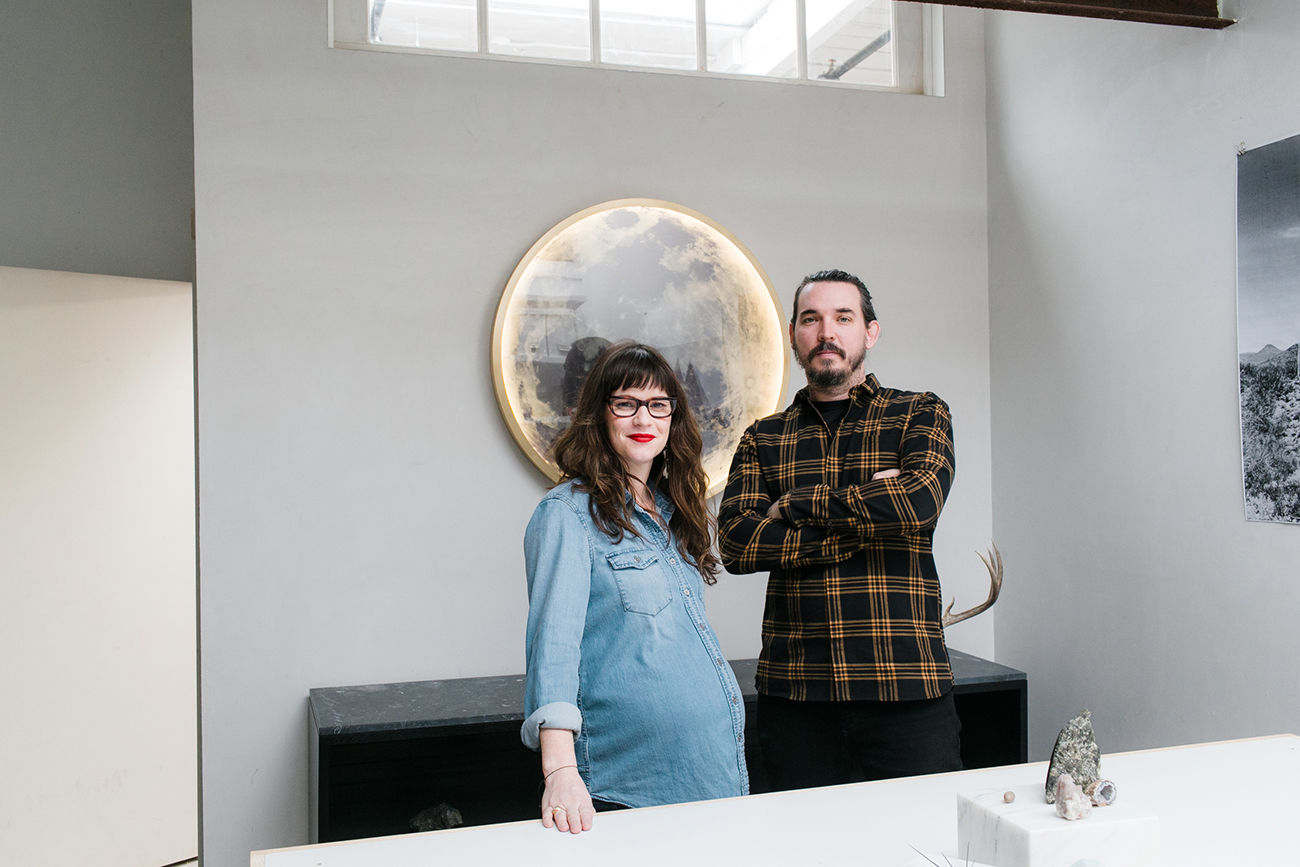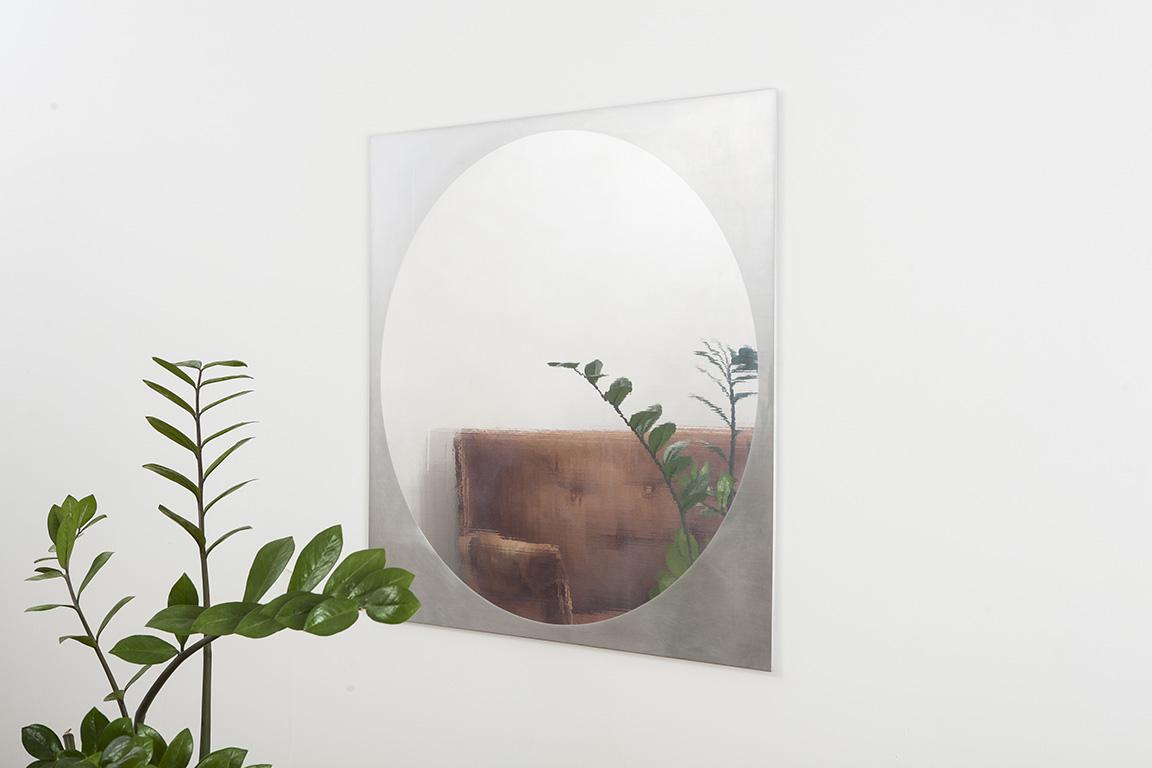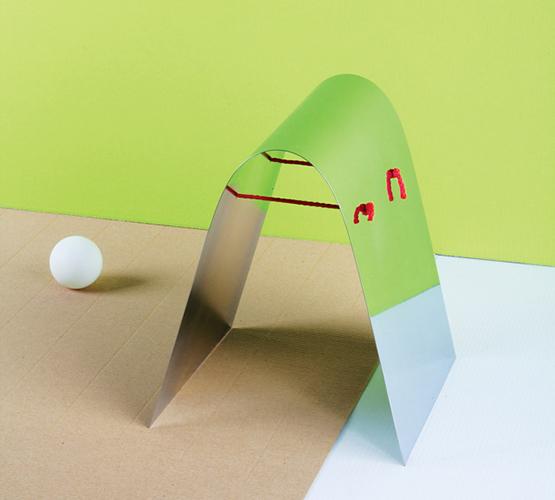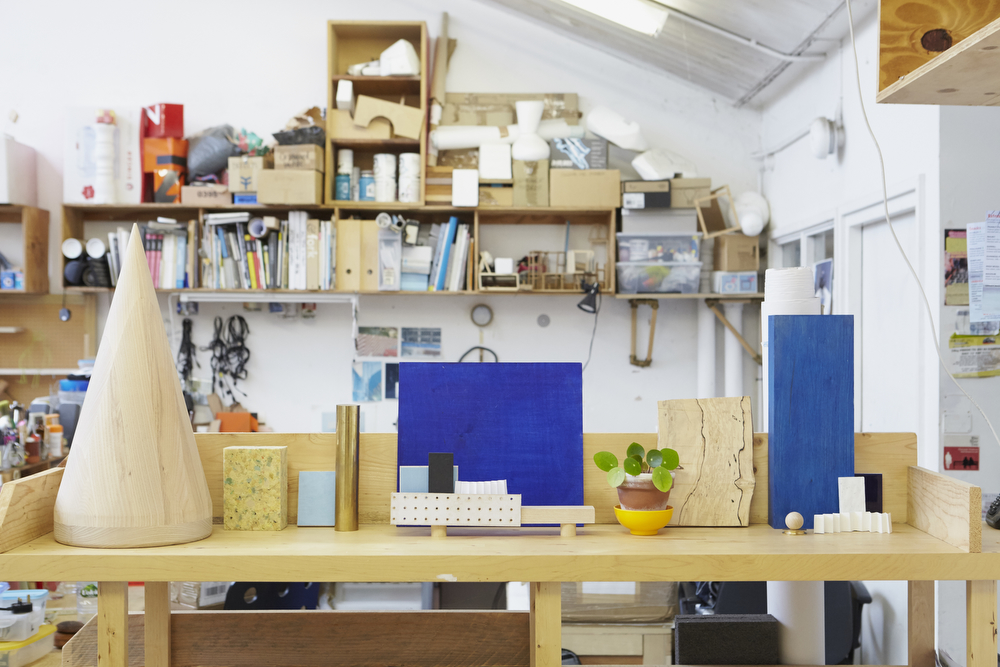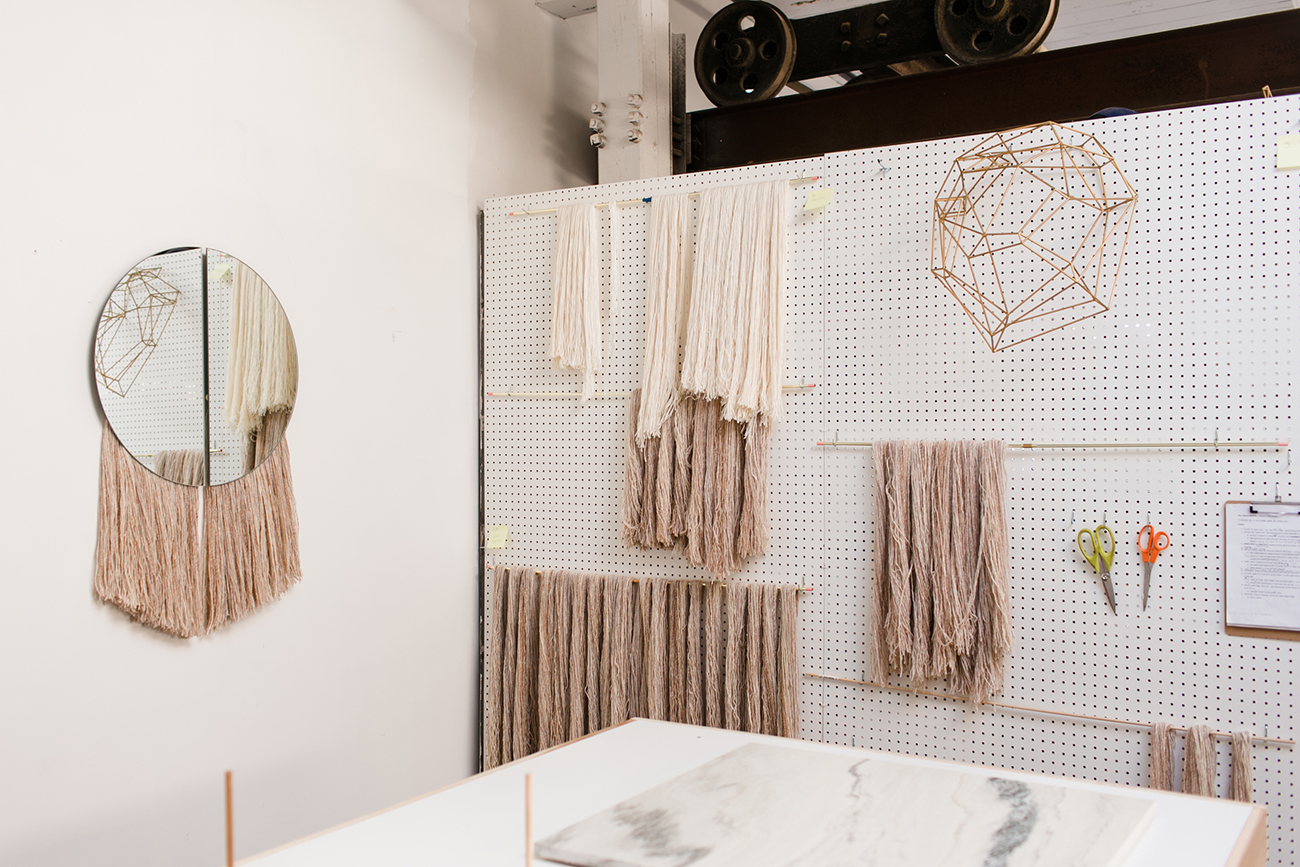
06.23.16
Studio Visit
When Is a Hairy Mirror Not Just a Hairy Mirror? Talking Materiality and Minimalism with Ben & Aja Blanc
PHOTOS BY RACHEL HULIN
Wood, bronze, marble, and minerals are just some of the raw, elemental materials Providence-based design duo Ben and Aja Blanc use to craft their minimal objects for the home. The couple, who graduated from RISD and were the unexpected darlings of last year’s Sight Unseen OFFSITE, have been collaborating for only a little more than a year and a half. But their fledgling partnership has already yielded more than a few instant classics. (Their hairy Half Moon Mirror, for example, was one of our favorite products of 2015 and was immediately snapped up by The Future Perfect). Their shared vision, which brings Aja’s fine art and museum background into dialogue with Ben’s experience as a designer and maker, translates into monolithic forms that speak to an ongoing exploration of materiality and formalism. “The tension is a challenge but it’s thrilling to balance out concerns about function, audience, and production with a true studio process of what’s inspiring us, what materials we want to manipulate, and what design questions we want to work through in our objects,” say the designers.
Happily, the two are beginning to grapple with those questions in the world beyond objects; their interior for the new RISD shop and cafe just opened yesterday, and they have an LA hotel project in the works. We caught up with them in their Rhode Island studio (just weeks before their second baby was due!) to find out what’s next.
Tiffany: You formally started working together in the last year — how did that come about?
Ben: Coming out of grad school, Aja ran the gallery guide program at Yale and worked with undergrads in the museum and I began a partnership with a fellow grad at that point. We bounced ideas back and forth for several years, but in a non-formal way. We got married and ended up in Providence, and Aja continued working at the RISD Museum while I started running a design studio solo. But behind the scenes we were always collaborating, discussing design from a design perspective but also from a more fine art, museum side of things. We realized that we enjoyed the collaborative process and formalized that relationship in January or February of 2015.
Aja: We realized that aside from enjoying the collaborative nature of the work, the work was better when it had those varying perspectives. That was a big impetus as well.
Ben: A lot of our inspiration comes from the fine art side. It was important for us to keep that string to the fine art world as we began to create work. We’re still very rooted in interior design, architecture, commercial projects, but there’s a spark or a seed that connects back to that museum and fine art side.
What differentiates your approaches to design? Could you describe the process of creating your projects?
Aja: We’re on the same page for many of the steps in the design process but what gets us excited aesthetically is a little different. I really appreciate minimalist form. Ben is very much into pattern. I’m a formalist. Ben appreciates narrative. But that tension and the process of working through is what drives the design process for us philosophically. I think the Moon Lights are a really good example of where we came together and worked through some of those issues. It has a really strong narrative but we also worked to create a real Minimalist piece. So the tension is super productive for us. The seriousness with which we treat our work and the way in which we talk about it is something we’ve brought over from the fine art, museum side. But though we’re excited by fine art, we’re definitely not the type of designers that try to make design that masquerades as fine art.
Ben: For our first collection, we were playing around with this idea of monumentalism and looking at natural forms as well as manmade forms that have that awe-inspiring presence or solidness or heaviness to them — simple things like mountains and outer space, the desert, vast expanses. So there will be an image or a word or something that clicks and one of us will say, “Hey, what do you think about that?” And that’s what ignites the sketching process for us. Then there’s the practical side of being designers and knowing there are interior designers and architects out in the world who want to place these things in people’s homes. On one side there’s that initial spark and on the other, there’s a conversation about, what do you think about a mirror, or what do you think about a wall sconce, or what do you think about adding a pendant light to our collection? They start to collide together in the sketching and model-making phase. It’s very collaborative. Usually there’s a pencil sketch from one us that sparks an idea from the other one. We have an open sketchbook.
Aja: Nothing’s sacred. One of us is going to come and sketch over your sketch and you have to be okay with that.
Ben: We’re obsessed with material and what we can do with it and how we can fabricate and how we can manipulate it. There are certain materials we’re really attracted to. Right now we’re fascinated by what we can do with bronze and the metallurgy of that. The current collection we’re developing is pushing that further. So that’s a starting point as well.
AB: I think the idea of tension is at the root of our design process. We almost set a design problem up for ourselves. With the mirrors it’s: ‘Is there a way to use texture and softness and fiber in a minimalist way?’ The answer is maybe yes or no but the object is the exploration of that question or that idea. Is it possible? Can you do that?
The Apollo Mirror melds two seemingly contradictory themes — mohair, silk, and wool are juxtaposed against rectilinear glass. Can you talk about your approach to mixing materials and what you hope that conveys conceptually?
Ben: It’s playing with tension. It’s having a vocabulary of materials we’re comfortable working with and then challenging ourselves to say, ‘Why can’t we put this soft, natural fiber with this hard edge? What happens when we do? What conversations come up when we do that?’ That’s more the materiality conversation that’s happening. But there’s another part to it. We love minimalism, but I think there can be a danger of the idea of design being cold and unapproachable. We’re constantly fighting that: How do you create a formalist, minimalist piece that has some life to it? The word we’ve been kicking around lately is “spirituality.” How do you add an essence of spirituality or life or soulfulness to the objects? We don’t do that in an overt way but it’s definitely part of the conversation; maybe the end user that can add their own conversation.
Aja: Every material, every object comes with a history. A table comes with a vernacular. A mirror is understood by the world in a certain way and you can’t pretend as a designer that your objects don’t carry all of that baggage with them. What if you work with the baggage? The baggage of a mirror is that it’s supposed to reflect back your face and that’s what it does. So what happens when you take something that’s completely functional and add something to it that’s completely non-functional? Something that Ben has been talking about is aesthetic function. You have a functional object that serves a purpose and then you pair that with a material or a shape or a form that serves no function, that serves some sort of aesthetic function. With the Apollo Mirror, people think it’s funny, it’s a hairy mirror. I love that; I think that’s a wonderful conversation to have that the piece does on its own.
A lot of times the discourse around design can tend to focus on form and not necessarily address these broader functionalities.
Ben: It’s interesting. At what level do objects function? Aesthetically, functionally? Some objects take on a patina over time and take on new meanings. Your grandfather’s medicine bag or a lamp your great-grandmother had or a tool. And there’s a real fascination from a narrative side. Are you able to create entry points into objects that maybe help facilitate that happening? I think we’re in the early infancy of working through these ideas in our objects but it’s something that is important and is running through the content that we’re doing. It’s not just a hairy mirror. But it can function for someone on that level. I don’t know that at this point we’re concerned about conveying that conversation so much to others. We just want it to function and for people to enjoy the object as a decorative object and find it beautiful or interesting or aesthetically appealing. It can be all of that.
Aja: All of this is important for us but we hope that it doesn’t get in the way of people using it. We’re perfectly comfortable with someone choosing a mirror because it matches their sofa. That’s valid.
What was the first collaborative project?
Ben: We were developing a collection thinking about interior space. We were trying a lot of hats on early in the process. Apollo was the second one we worked on. The Half Moon Mirror was the first one we had done. We have a bronze Apatosaurus that truly is a sculptural bronze, limited-edition piece.
Aja: Not only was it our first collaborative piece but you could not find a piece that is more so. We literally with both our hands sculpted it with clay and we did it together both sculpting and messing with the clay at the same time. There were four hands on that 17-inch sculpture.
Ben: Early on we thought if we’re going to collaborate, we’re just going to embrace the idea of collaboration and really go full into it. So it’s not like Aja’s working on a set of objects and I’m working on something separate, it is very much integrated, both giving input, both shaping the clay in different ways and responding to one another. I’d say the first collection all happened simultaneously in some ways.
Aja: Ben has a really amazing background understanding how to make things. It was easy for me to say, let’s make this, but sometimes the laws of physics don’t allow for that. It was a fun and funny way to start. With me being like, “Why not?” But then going back and thinking what if it could work?
I’d love to hear more about the RISD Museum cafe (above) and shop you recently designed. What is the idea behind it?
Ben: They asked us to re-imagine one of the gallery spaces as a café and new admissions area. Aja and I both being RISD alumni are partial to RISD and its history so we went into the archive looking at amazing photos of dining spaces where faculty and visiting artists and critics were colliding on campus around food, around dining. We found photos of Warhol in the cafeteria and David Byrne hanging out eating.
Aja: And old dining spaces on campus that don’t actually exist anymore. We were looking at that history and the culture of these various groups coming together at RISD, knowing that the museum brings in the public aspect of Providence. So there’s a really wonderful opportunity for all of these communities to come together. That’s an exciting opportunity for the museum and it’s an exciting opportunity for us. Museums are these other spaces. People can feel uncomfortable, it’s a space where it feels like there are a lot of rules and people don’t always know how to act but a café is a bit more of a familiar space — the café is a portal to comfort in the museum. We wanted to push some aesthetic boundaries while also maintaining a level of comfort. And that’s a tricky thing. It’s something we’ve tried to work through in our design.
Ben: It speaks to our way working with our objects. Going into the archives and finding a foundation, finding a narrative as an inspiration or a starting point. It gets the project rolling and it gives a feeling or atmosphere to the project. Then we switch and instead of looking backward we start looking forward. As Aja said, ‘How can we create something that has an essence of the past that begins to create its own narrative and look forward?’
Your studio is in Providence. Are there qualities about the city that drew you to live and work there?
Aja: I think a big part of it is that the artistic community here is really awesome. There is a growing design community but the fine arts, performance, print making — those are really strong here and really important to us. I think there is a total scrappiness and grittiness to the art scene here that is informative for us and our work.
Ben: There’s a really strong undercurrent of an artistic community that’s accepting of the printmakers colliding with the designers colliding with the painters colliding with the sculptors.
Aja: There’s a real directness in the making of those forms. Design can be really complex and have so many moving parts and pieces that I think it’s useful to be surrounded by some of these hands-on processes and thinking about the directness of those.
Ben: Also Providence just has such a history of making. The jewelry industry was basically founded here and a lot of the ma-and-pa factories still exist. As designers, we have access to an amazing array of technologies and lost arts: metal casting, bronze casting. At the heart of it, we’re makers. We have our hands on almost every object that leaves our studio in some way or another, even if we are working with other fabricators. That’s really important to us. There’s a mental space to expand and try on new things and techniques without the pressure of fitting in.
Aja: I think weird is alive and well here.
How important is it to your practice to work locally, both for manufacturing as well as locally sourced materials?
Ben: It’s incredibly important to us. We don’t push it as it’s not necessarily important to our clients. We’re both national and international. We just sent a piece to London, one to Paris. Someone in London is not that concerned that it was made in Providence so it’s just not part of our public side of the branding. But for us as makers, it’s incredibly important because if we’re close to the source, we can be in the metal shops, we can be with the woodworker having oversight in terms of quality. It allows us flexibility to play. We can go over and say can you try this, or try that. If we weren’t working with someone local, we wouldn’t have that flexibility and be as able to experiment.
Aja: It’s more collaborative with some of our relationships here because we’re afforded the proximity to do that, to actually go into their shops and talk with them and work through ideas. That’s been really awesome.
Are there any materials you haven’t yet worked with that you’re dying to make something with?
Ben: Ceramics for sure, that comes up a lot. We just haven’t found an entry point for it yet. We’ve been thinking a lot about the idea of gold and crystals. Our studio is actually filled with crystals in every size imaginable and we see them and wonder how we can manipulate them and use them as a raw material.
I really enjoy the space, how organized it is and how that reflects the almost reductive aesthetic in your work. I was also particularly interested in the found inspiration images. How do you find and interpret your inspirations?
Aja: Both of us are pretty voracious aesthetic consumers. We really enjoy taking a lot in and then it’s a reductive process where you filter out, as opposed to specifically going out looking for references that match what we need. It’s more like we’re going to take it all in and then filter out in that way. We’re collectors — that’s a huge part of it. It’s tricky to be collectors who also want to be very precise and organized.
What do you collect?
Aja: We collect a lot of found materials, nature materials. We have a very large crystal collection, flotsam and jetsam, trash. [Laughs]
Ben: But we’re collectors, not hoarders. There’s a lot of collecting and organizing and putting on shelves.
Aja: It’s a really useful process for us. Ben is always in the studio with our maquettes of things constantly rearranging them. It’s a useful thing to do as a creative person. We enjoy it.
I noticed that there’s not a lot of color in your studio. Was that intentional?
Aja: That’s so funny you said that because I saw the images for the story and I thought, wow they’re so colorful. [Laughs.] I’ll let Ben speak for himself because every once in a while he’ll be like ‘I love this hot pink thing’ and I’m like wait. What happened? I am pretty monochromatic but what’s ironic is that another thing we collect is fine art. In our own home we have some loud, colorful fine art. Then it’s the furniture and other aspects in the room that are very monotone and quiet so that the art can speak up. I wonder if that’s coming out in our work as well. I think color is baggage and I like the pieces being free of that baggage.
Ben: I’m not afraid to use it. It’s just not part of our studio dialogue right now. We’ve been really pushing form and material and the material’s natural color. Right now we have this muted palette. Even the RISD café is blacks and creams. I think it’s just where our mood and interest is. I can’t say that we’re never going to work with color because that’s probably not true. It just happens that a lot of materials we’re drawn to are more natural.
Some of your work exists within the collectible design realm. What does it mean for you to be a part of that community?
Ben: I get very excited that the collecting of design is happening and I’m very thrilled that we’re a part of it but not in any kind of direct, conscious way that we’re designing for that specific market. We’re just doing our thing and if people find us, that’s awesome.
So you wouldn’t rule out a mass-produced object or are you drawn to the intimacy of the more handcrafted, one-off, smaller scale production?
Ben: We wouldn’t rule it out but that’s not how we live our lives. I think we’re trying to be as authentic as possible. That’s such a word right now in the design community and I think that’s what we’re trying to do. We live with the work we make and our home life is filled with crystals, minerals, and materials and our studio is filled with it and it’s all connected. We like the limited, high-quality, handmade objects. There’s a soulfulness to them that we’re drawn to so that’s our preference. But whether it’s mass produced or a one-off, the design challenge is what’s exciting for us. I’m sure there’s a way to introduce some of that into mass-production but it’s not something we seek out.
Now that you’ve expanded from objects to interior spaces like the RISD project, is there anything in particular you’re excited about tackling next?
Aja: We’re excited to present new work. We’ve been thinking about installations from a fine art perspective and thinking about ways in which one presents their work and the spaces and the company it’s in and how that affects the conversation you have around them. In a more general sense, we’re excited to just keep pushing ourselves this year and continue to evolve our partnership.
Ben: We’ve done some smaller scale interiors and did the bench seating at the Yale Art Museums, so from an interior standpoint, I think diving into that more. We have an interest in pursuing that some. Just pushing our conversation in the studio and pushing materials is the biggest thing.
Aja: It’s those bigger questions that we think about.
Ben: We’re just really curious. There are so many questions we have to ask and find out. There are also collaborations we would like to do. We worked with Calico Wallpaper on a mural for the RISD installation so ways of playing around, asking questions, and just having a blast.
